Three years ago, I went on a hiking holiday in South Tyrol for the first time. Since then, I have been head over heels in love with this northern part of Italy, which once belonged to Austria. The authentically friendly South Tyroleans, the incredibly beautiful mountain world, the excellent hearty food – and all this combined with the Mediterranean influence that becomes stronger towards the south – all this together creates a mixture that has taken my heart by storm. Since then, I have been there at least once a year on a mountain hiking holiday, sometimes even twice. One thing is certain: a part of my heart will irrevocably and forever belong to South Tyrol. Translated with DeepL.com (free version)
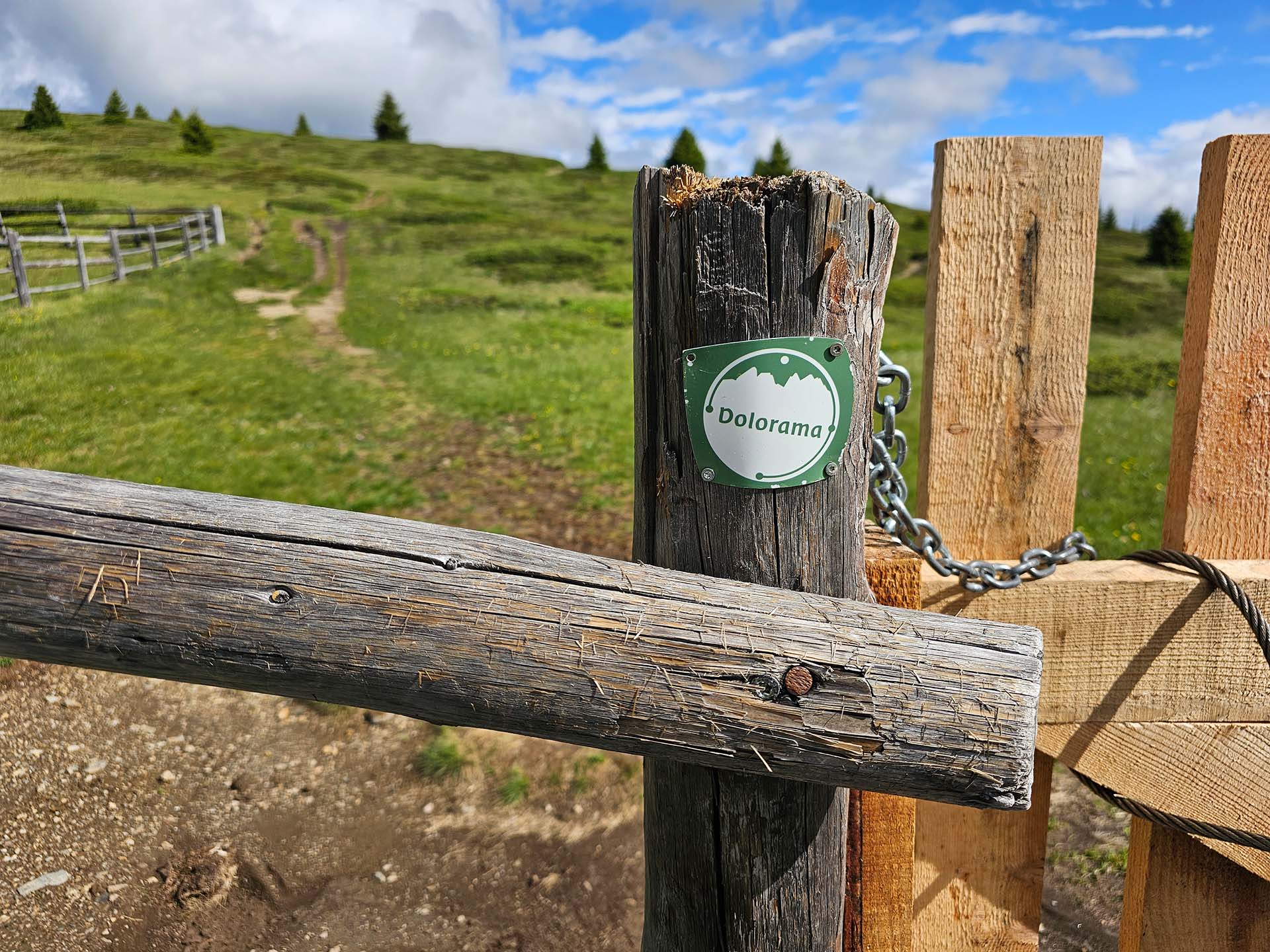
This year, however, I planned my South Tyrol holiday a little differently. Instead of staying in an apartment again and starting my day hikes from there, I wanted to walk from hut to hut on a long-distance hiking trail, namely the Dolorama, which leads from Rodeneck to Lajen.
Physically, this type of hiking holiday is much more demanding, as the huts are booked in advance, meaning that spontaneously staying an extra day at a hut to rest is not an option. Of course, you can plan the tour individually and shorten the daily stages, but I spared myself this work, did a lot of sport in advance and relied on my strength and endurance – in the hope that they would not let me down.
The Dolorama is actually designed as a 4-day long-distance hike , but there is a 5-day versionwhere the first stage is split. This allows you to start the first day at a leisurely pace and ease yourself into it – and I am very glad that I opted for this version. More on that later, though.
My preparations for a 5-day long-distance hike
The necessary preparations for a long-distance hike consist of three parts – the athletic side, the planning and the luggage. You can find my packing list for this tour at the bottom of this report.
In terms of fitness , I am at a consistently good level. I keep fit over the winter with muscle training and treadmill workouts at the gym, which means I always have a good basic level of fitness. However, I still tried to fit in a few mountain hikes before my hut tour. I didn't manage to match the duration and altitude difference of my Dolorama tours, but I would definitely recommend it.
The rule is: the better your fitness and strength, the more fun multi-day hiking tours are.
The planning effort for my multi-day tour of Dolorama was kept to a minimum. This was mainly because I followed the standard route and therefore did not have to make any changes that required extensive research.
The most important points to bear in mind are nevertheless:
- Getting there: By train or by car? When to arrive – might you need an extra night in the valley before the first stage? I travelled by train and used public transport once I was there, and I'd do it again in a heartbeat.
- Weather forecast
- Duration: You don't necessarily have to walk the entire length of the Dolorama. From each hut, you can simply descend into the next valley. So if you only want to walk for three days, that's no problem at all.
- Hut booking: It is definitely advisable to book huts in advance on such a popular tour. You can either book early and then (taking into account the cancellation period) keep the booking if the weather forecast is good or cancel it if the weather is bad. Or you can wait for the weather forecast and then book at short notice. I booked the huts 10 days in advance, and one was already fully booked, so I had to change my plans a little (see stages 3/4).
- Equipment: Do you have everything you need? If you buy new hiking boots, for example, you must break them in beforehand. Nobody wants to suffer from ill-fitting shoes or blisters on a long hike.
Let's go – 5 days on the Dolorama long-distance hiking trail in the Dolomites
Of course, I viewed this trip as a sporting challenge – after all, I had many metres of elevation gain and kilometres ahead of me. However, it was also a holiday, so I took a relaxed approach and travelled to Mühlbach the day before the first stage. I spent a night in a hotel there and then took the hiking bus from Mühlbach railway station to the starting point of the hike.
Money-saving tip : If you are travelling by public transport, check whether your hotel is a South Tyrol Guest Pass establishment. This allows you to travel free of charge on all public transport in South Tyrol from the day of arrival to the day of departure. If you have it sent to you after booking your hotel and before arrival, you can travel free of charge from the border onwards and save money straight away.
Stage 1 – from the Zumis car park to the Kreuzwiesenalm
Distance: 9 kilometres | Duration: 2:15 hours | Elevation gain: 330 metres | Elevation loss: 140 metres
Check out my tour on Komoot
I took the first hiking bus 415 of the day from the train station in Mühlbach to the starting point at the Zumis car park. It's really practical, comfortable and fast – and, unlike the parking fees for the car park, a very inexpensive option. The bus climbs numerous metres in altitude on a winding mountain road – hats off to the bus drivers!
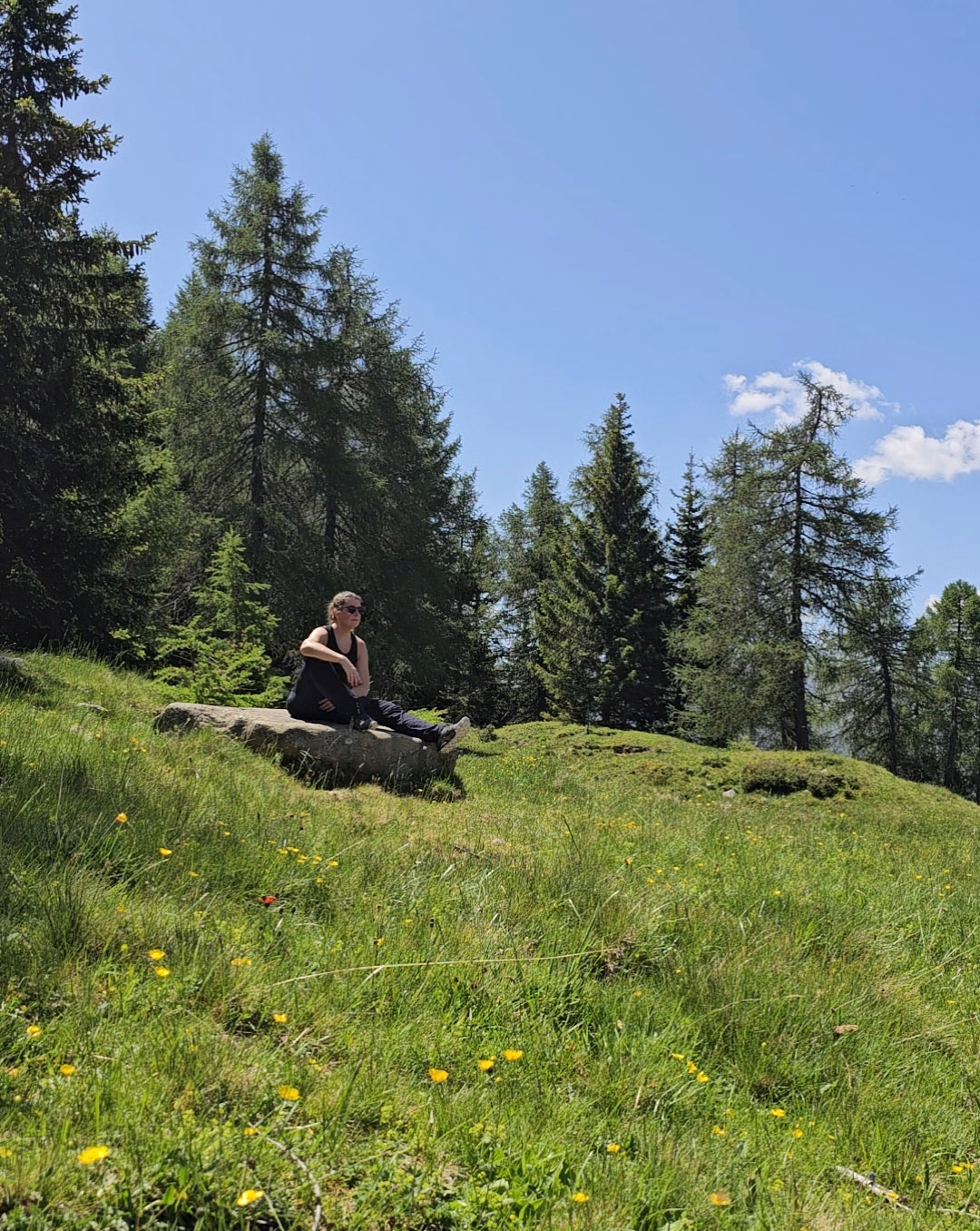
There are large information boards and signposts at the Zumis car park. Just follow the main hiking route, which is super easy. On this first day, only easy forest roads are on the agenda. Although I got off the bus with lots of other people and, of course, a few cars arrived at the car park, I quickly found myself alone, walking along the Creation Trail . In eight stations, you follow the biblical story of creation. While I'm not interested in the religious part of it, I'm very enthusiastic about the implementation and the impressive sculptures.
As easy as today's stage is in terms of distance, it doesn't feel easy at all. The reason: my rucksack weighs an estimated 12 kilos and is extremely heavy. It's a real burden and makes it difficult to move forward. In fact, it makes me very nervous, because I know that the first stage is more of a walk than a hike. So what will it be like over the next few days when we approach 1,000 metres of elevation gain and 15 kilometres per day?
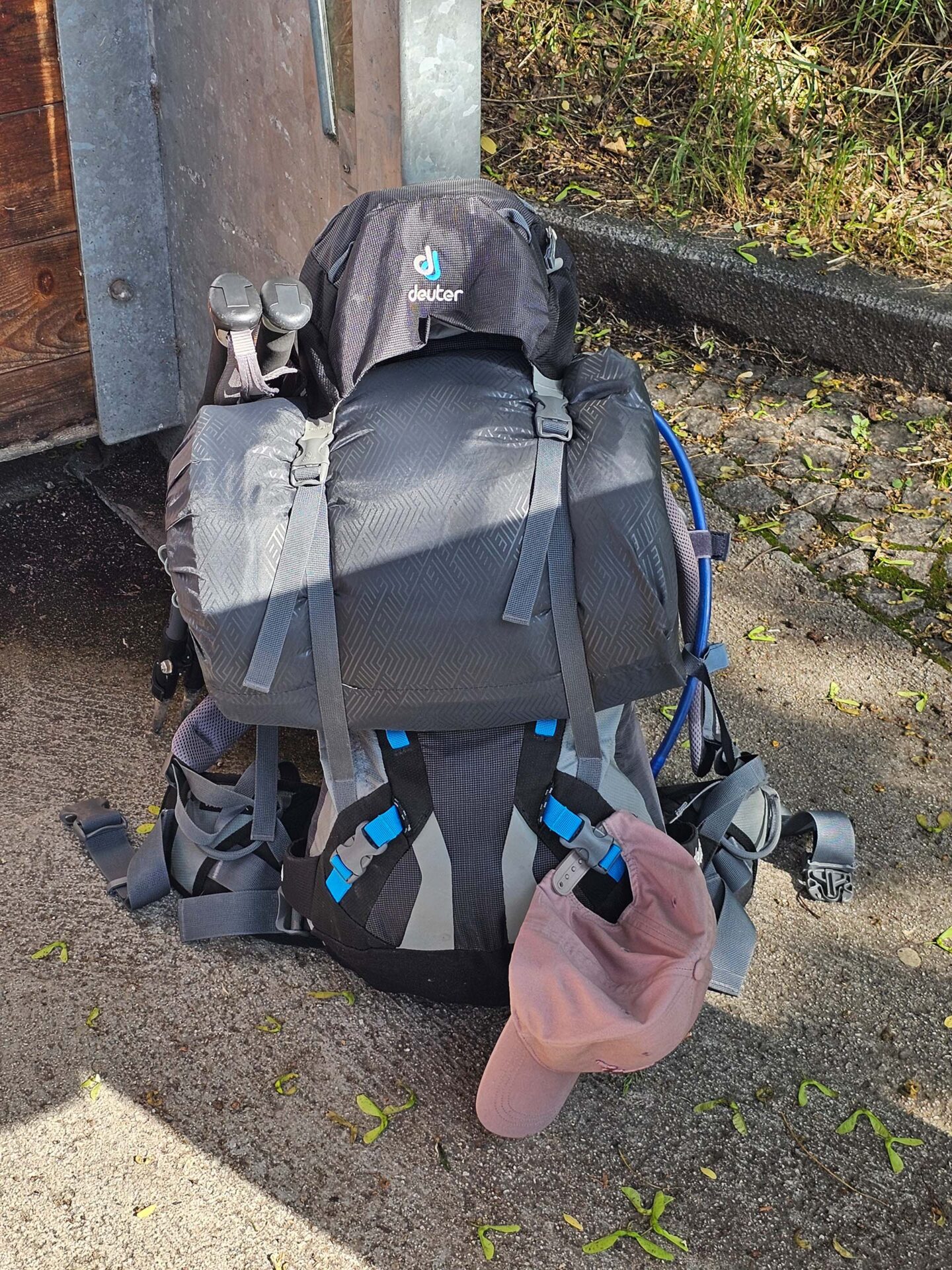
I follow the road through the woods and between alpine meadows. The ever-impressive peaks of the Dolomites loom in the distance, and I am very much looking forward to soon being right in the middle of them.
After a little over two hours, I arrive at the Kreuzwiesenalm . I definitely could have taken a later bus or even arrived on that day. Although I am quite exhausted from my heavy backpack, the stage is very short and I arrive around noon.
The Kreuzwiesenalm is a very beautiful hut with a large meadow in front of it. There is also a sauna house (which was not open when I visited) with a plunge pool and a children's playground. No wonder, as the path here is perfectly suitable for strollers.
I can't check in yet, so I make myself comfortable. That was the plan, after all, I'm on holiday! 😊 I treat myself to a wonderful Kaiserschmarren and then move to the sun loungers by the sauna hut, where I unpack my e-book reader and read with a view of the mountains.
At around 3:30 p.m., I move into my accommodation in the annex. There are two showers on the ground floor, and a steep staircase leads up to a classic hostel dormitory. It's not fully booked, and I'm early, so I find myself a bed by the wall. There are plenty of power sockets.
Wie jede Almhütte in den Dolomiten, auf der ich bisher war, ist auch auf der Kreuzwiesenalm das Essen ausgezeichnet. Beim Abendessen ergeben sich die ersten Gespräch mit anderen Wanderern, viele davon machen die gleiche Tour wie ich.
Während der Nacht zieht die vorhergesagte Gewitterfront durch. Im Lager schlafend hat das schon Kraft, und man wird sehr deutlich daran erinnert, dass die Beachtung von Wettervorhersagen im Gebirge entscheidend ist. Die Wetterlage ist generell instabil angesagt für die kommenden Tage, deshalb will ich immer sehr früh aufbrechen, und das kommt meinem Dasein als Frühaufsteherin ohnehin entgegen.
In the morning, I am ready and waiting in the breakfast room at 7:00. The buffet breakfast is excellent and really extensive, almost hotel standard. The cheese, butter and jams are produced in-house and are so good!
Well nourished, I shoulder my rucksack and am the first to leave the hut.
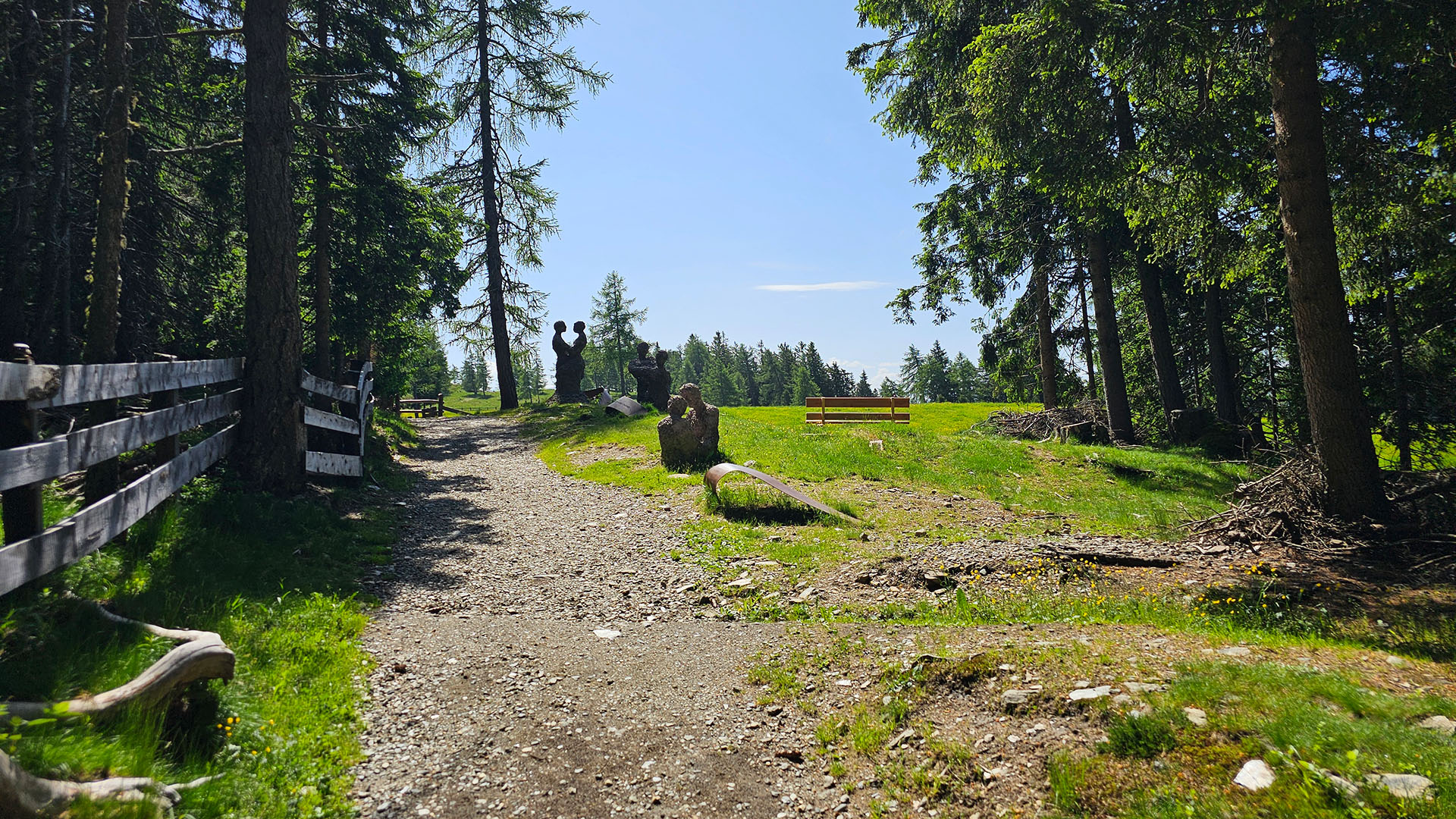
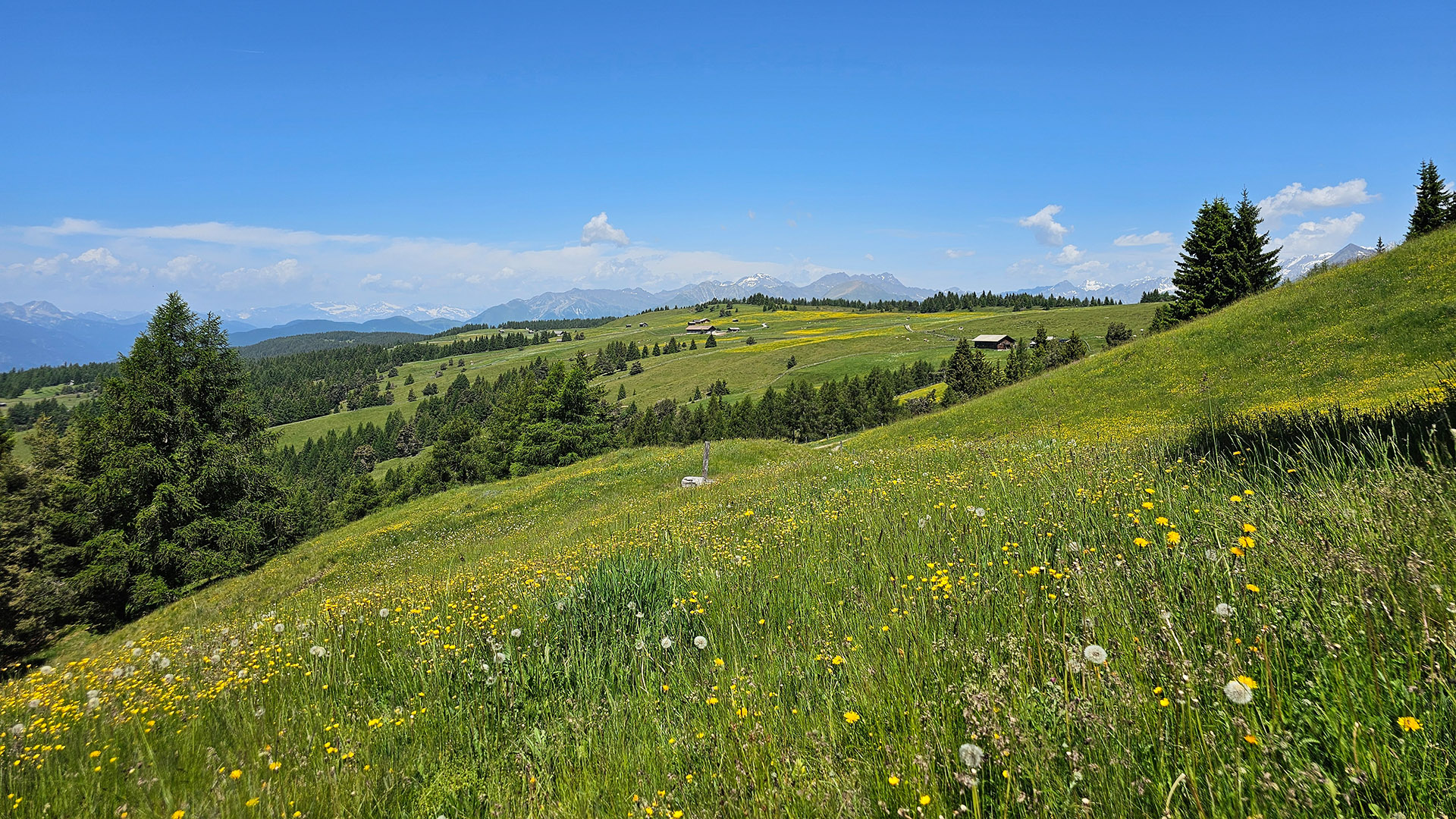
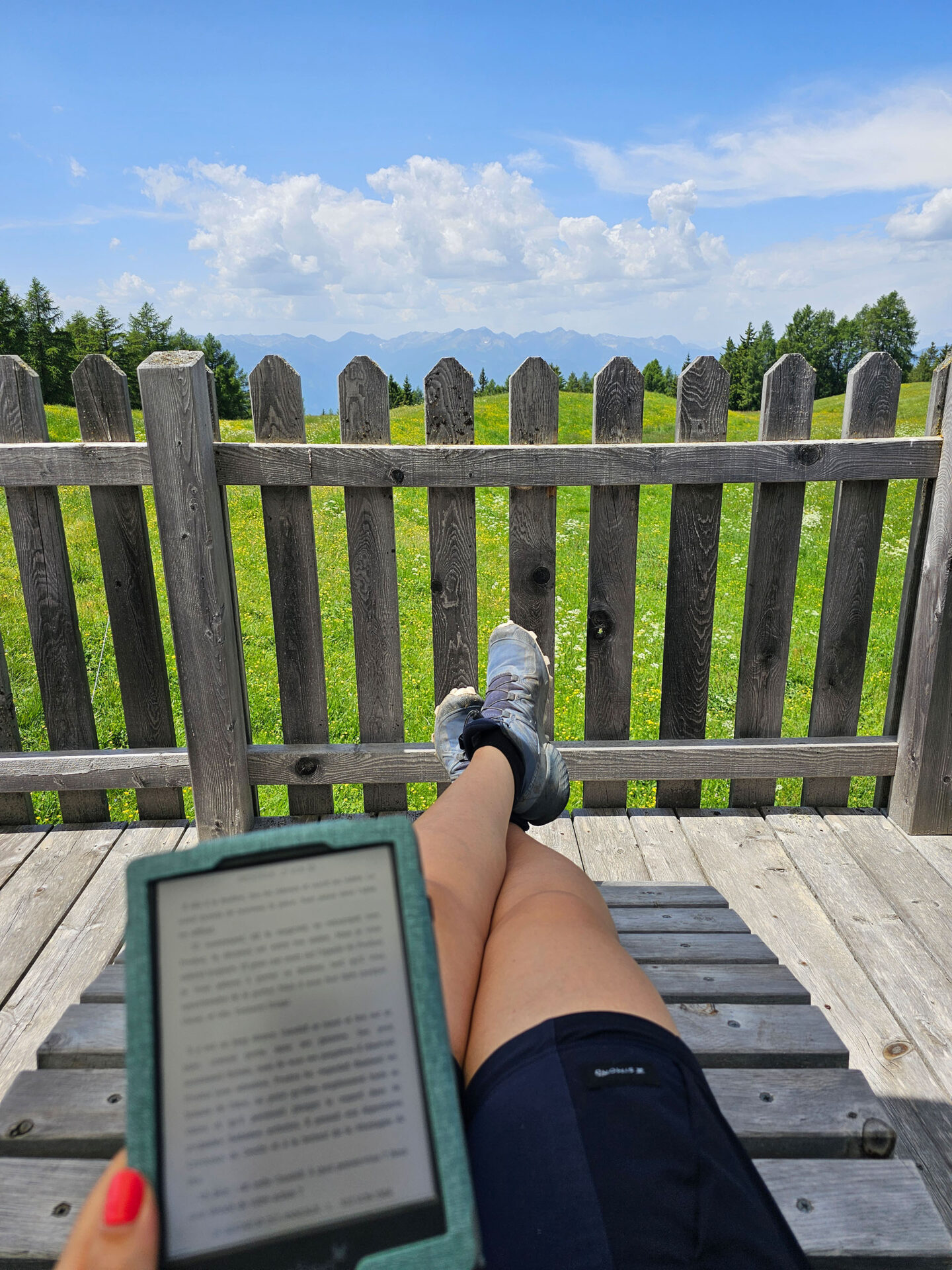
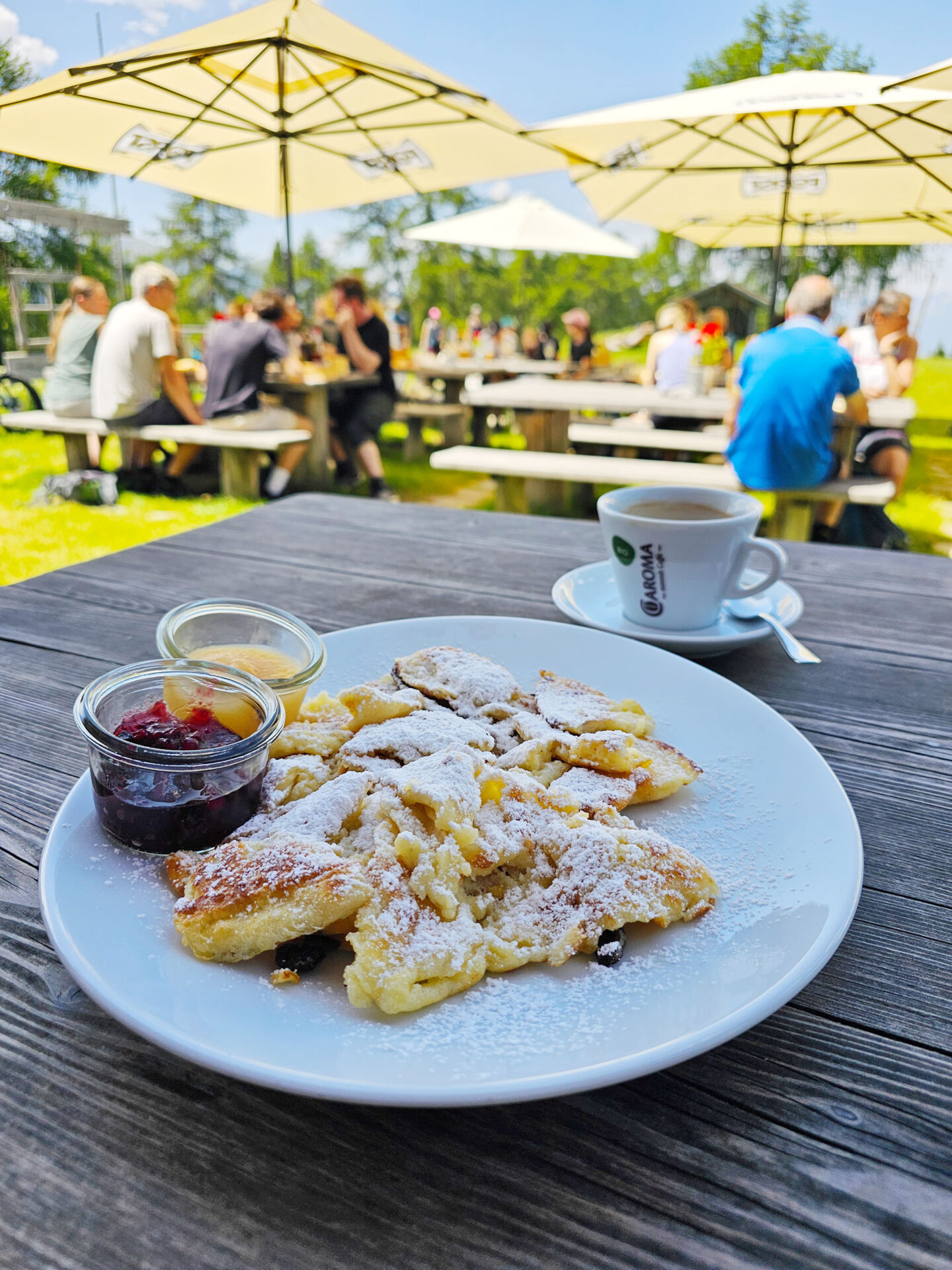
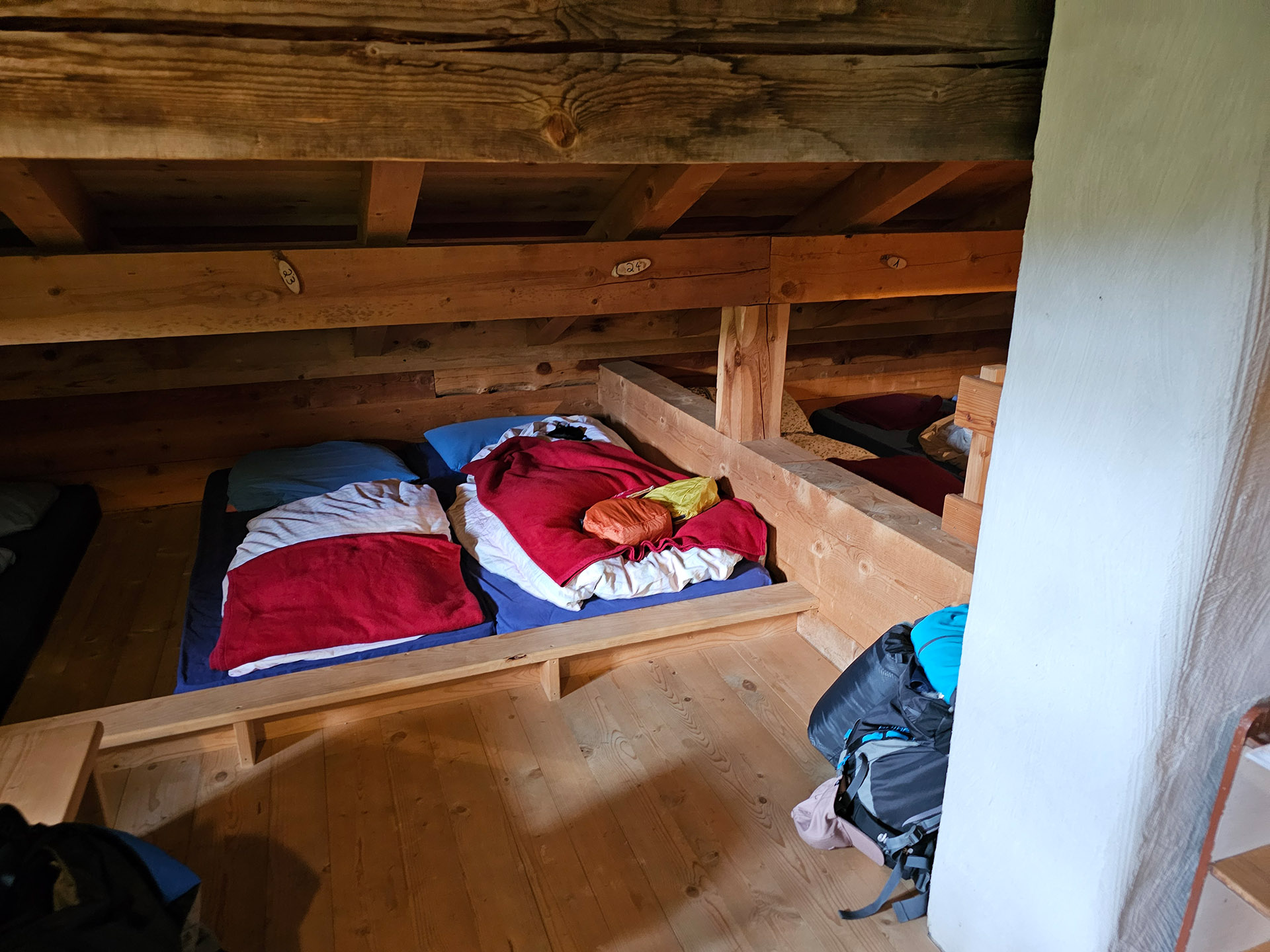
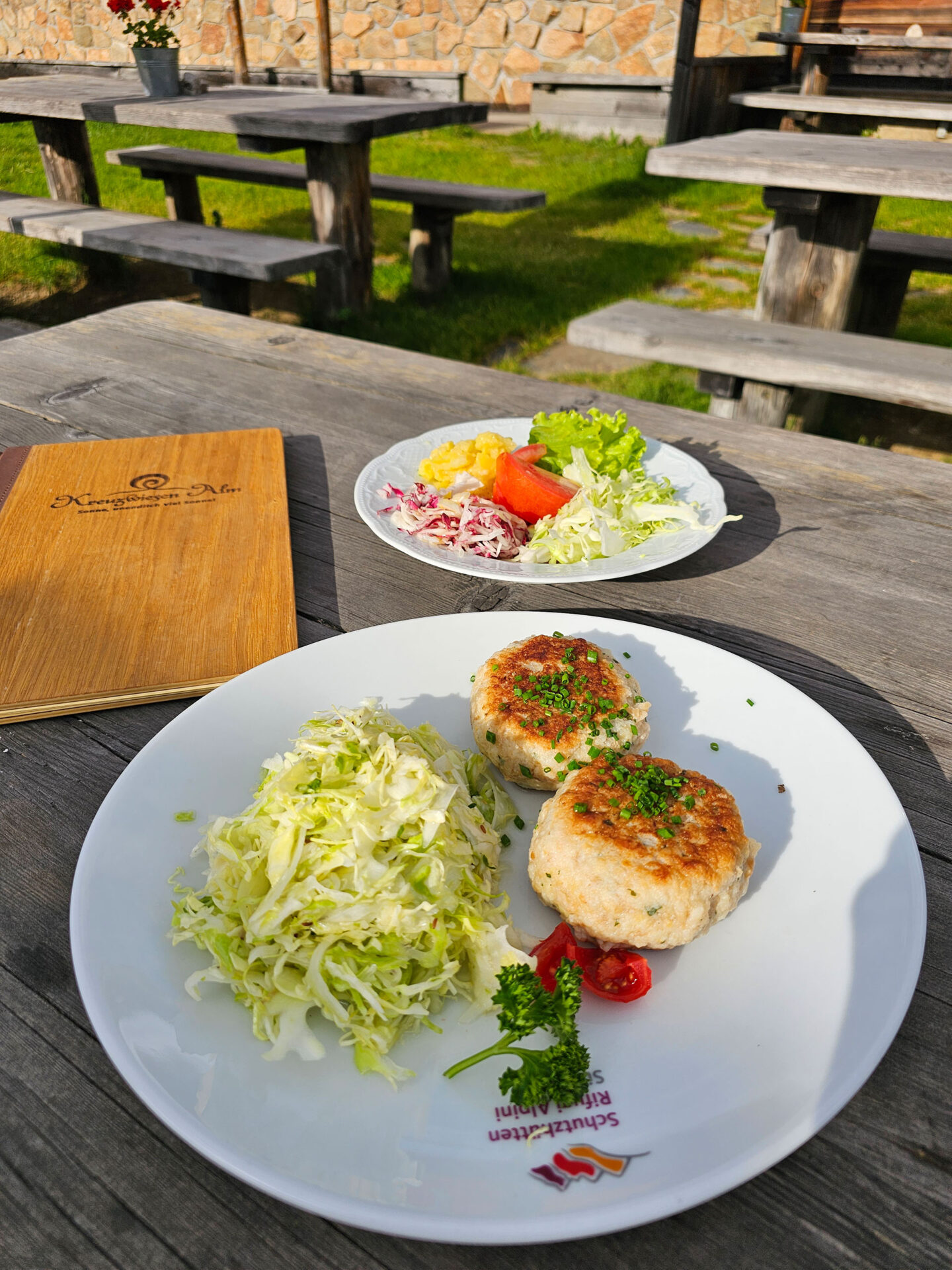
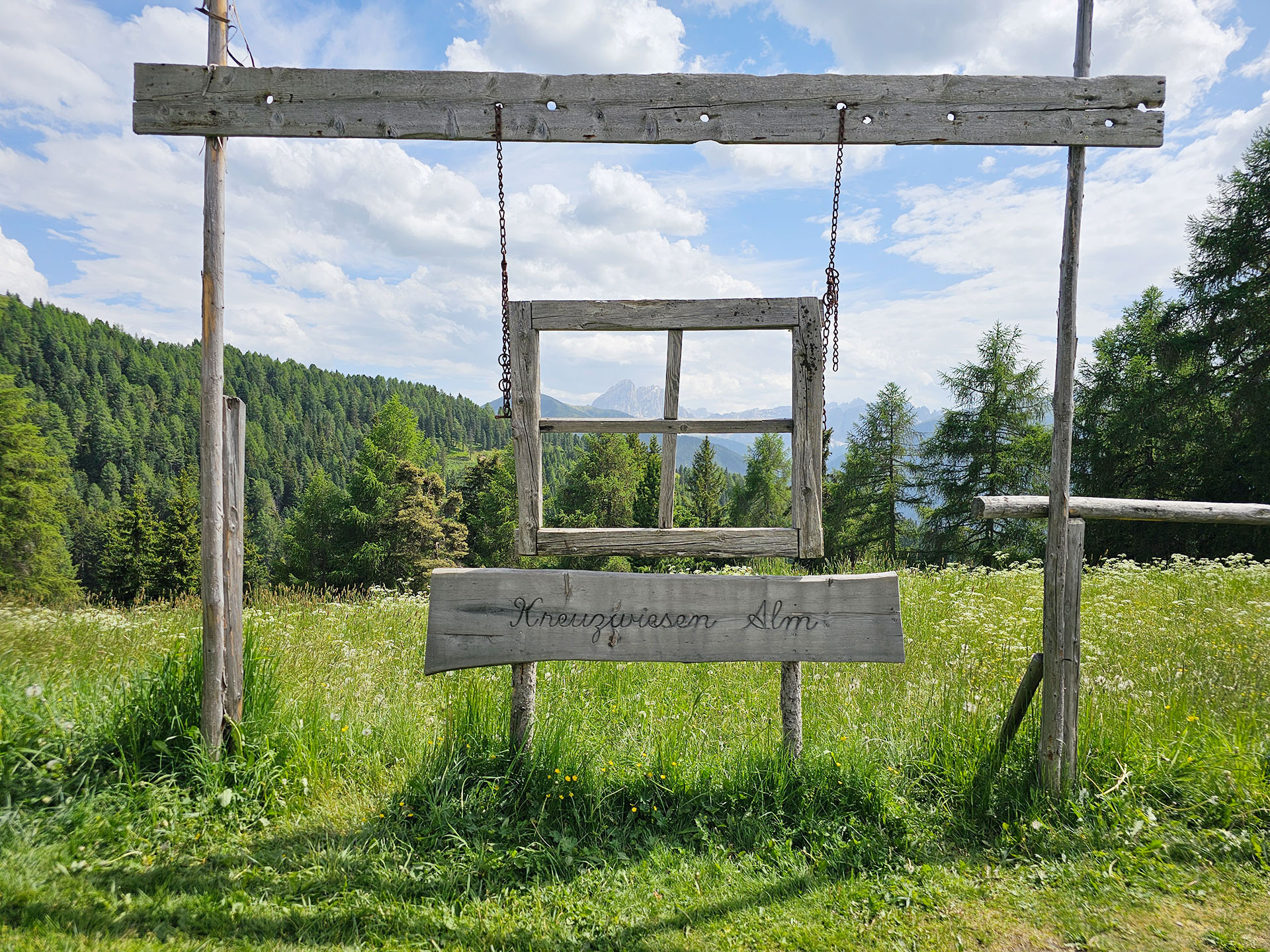
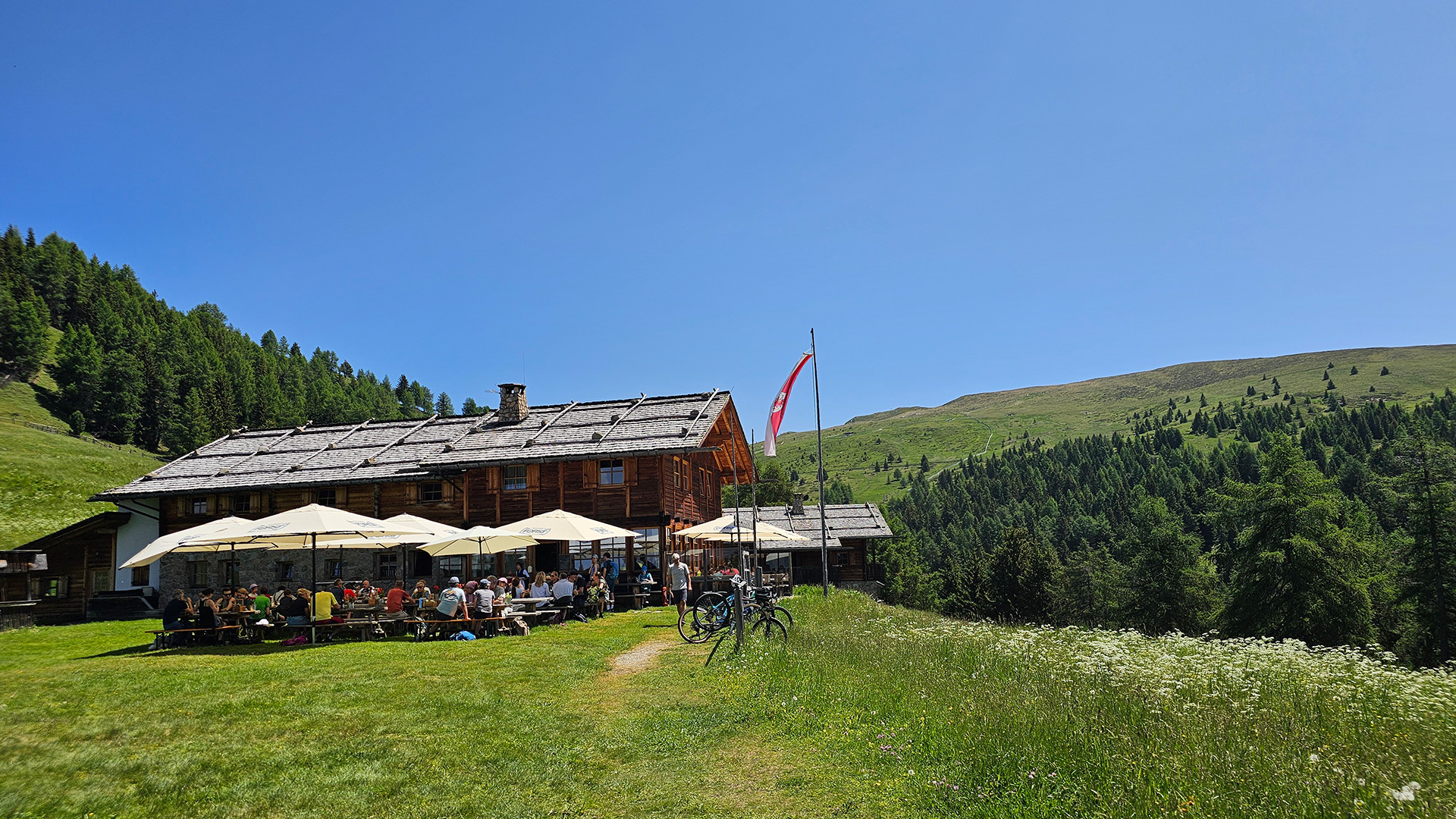
Stage 2: from the Kreuzwiesen Alm to the Maurerberghütte
Distanz: 14,2 Kilometer | Dauer: 4:20 h | Höhenmeter bergauf: 960 m | Höhenmeter bergab: 760 m
Check out my tour on Komoot
Let's get started on the first ‘real’ stage of the Dolorama. By the way, stages 1 and 2 combined would be the ‘actual’ first stage, covering a distance of over 20 kilometres and 940 metres of elevation gain. Now you know why I split them up.
And it quickly becomes clear that taking it easy the day before was the best idea ever: today, I can't even feel my backpack anymore. Apparently, I just needed the short hike the day before to acclimatise and get used to it.
At first, the route follows a gravel road, but then it turns into an alpine hiking trail, which is no more difficult than a classic red hiking trail. All day long, I follow the Peitlerkofel, which was still so far away from the Kreuzwiesenalm and is now getting closer with every step I take.
A possible culinary stop on this tour is the Welschellener Alm . To get there, you have to take a small detour and descend about 100 extra metres in altitude and then climb back up again – but you can sit in a wonderful garden with a view of the valley and treat yourself to South Tyrolean delicacies!
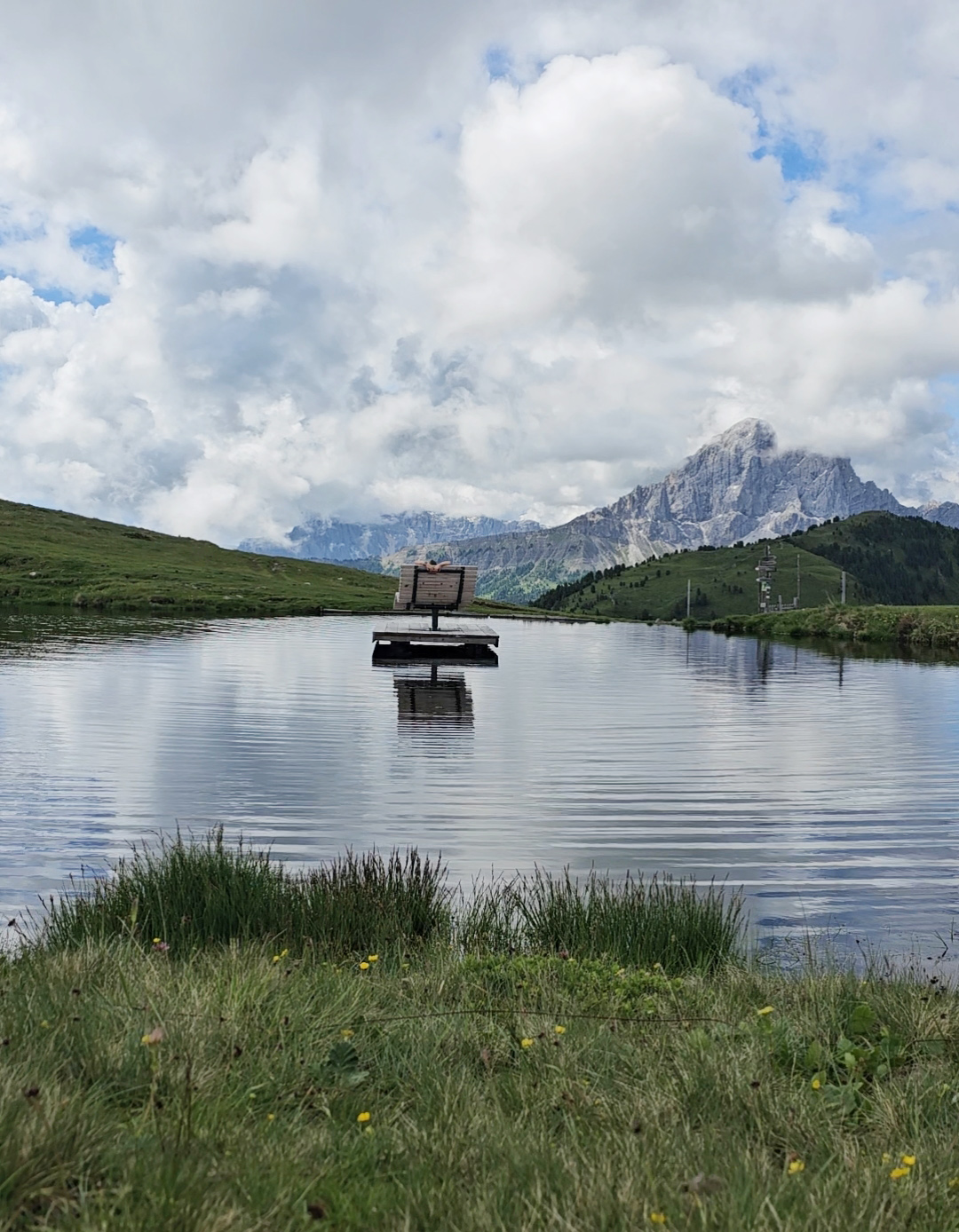
I take a break at the small Glittner Lake. For two years now, I have been enthusiastic about winter ice bathing and am therefore looking forward to a refreshing dip in a mountain lake. However, it is not very cold, probably because it is quite shallow. It is a moor lake, which means that anyone who goes in has to be prepared to sink up to their lower legs in mud. A sun lounger has been placed on a platform in the middle of the lake, which can only be reached by going into the lake – I love it! From there, you have the perfect view of the impressive Peitlerkofel.
I spend about half an hour at Glittner Lake, and yet no other people pass me by. Wonderful, it feels as if everything belongs to me. Getting up early really always pays off.
Towards the end of the hike, you are back on a forest road heading towards the Maurerberghütte . One signpost indicates that it is a straight hour's walk to the Maurerberghütte, while another signpost points to a steep path up to the right. Both indicate a distance of one hour, and I decide to take the alpine route – after all, I'm not here for a stroll.
After half an hour, it turns out that I misread the sign. One sign pointed to the Maurerberg hut, an hour's walk away, but the other did not also point to the hut (only via a different route), but to the Maurerberg. When I finally realise this, the way back is just as far as the way to the summit cross. The Maurerberg rises up in front of me, almost perfectly conical, and from where I stand I can see the long way up. Cursing inwardly, I set off. If I had checked beforehand, I would have taken the short and easy route. But now, 30 minutes later, I am standing completely sweaty and out of breath at the impressive summit cross of the Maurerberg, the Col da Lé. It is hazy and looks like rain, so the view is not really great. Nevertheless, as always when hiking in the mountains, the climb is arduous, but the triumph is all the greater. So on we go – from here it is only 20 minutes downhill to the Maurerberg hut.
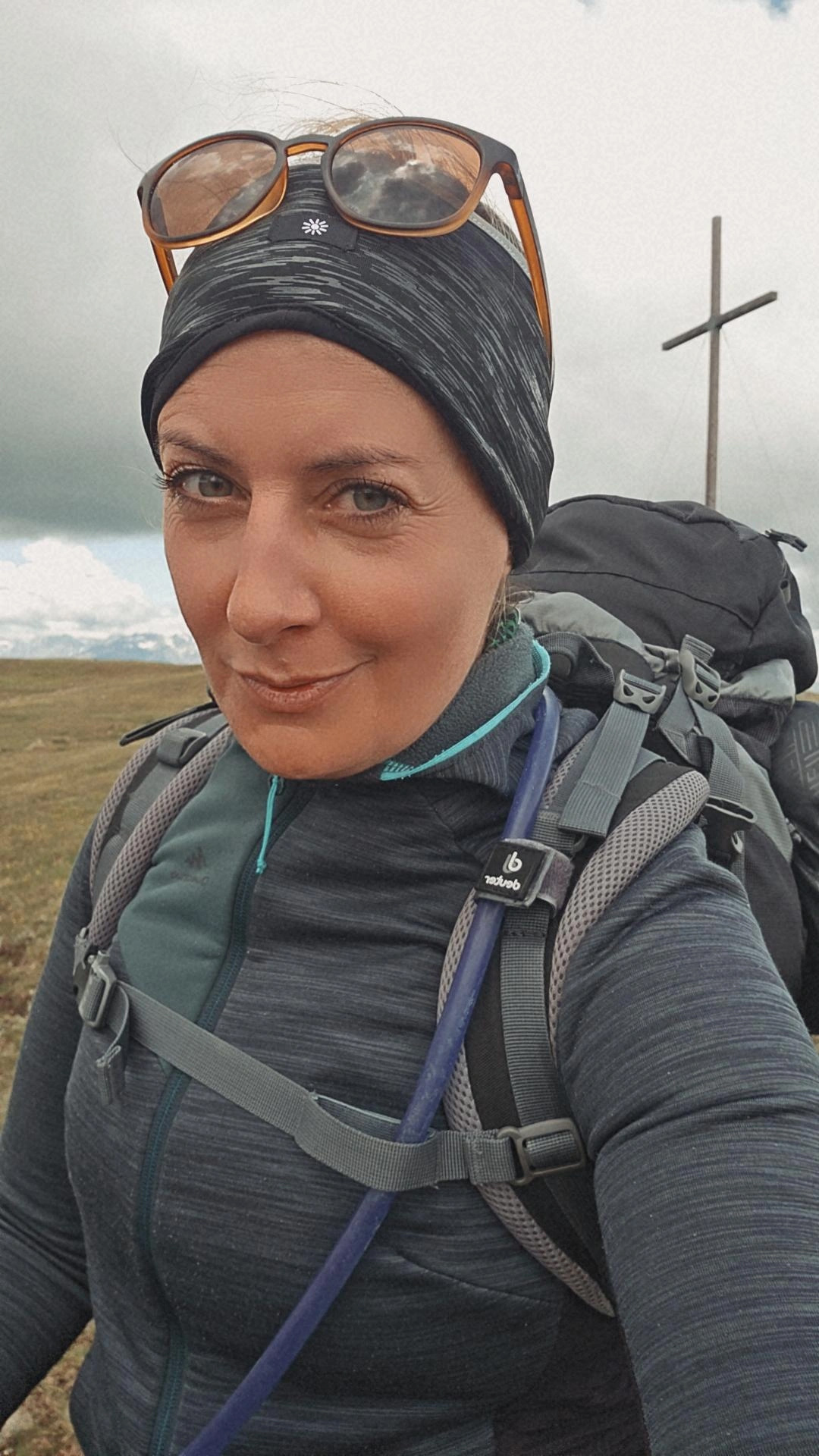
Directly opposite the Maurerberghütte, the impressive Peitlerkofel rises up and feels as if you could almost touch it. Tomorrow I will get to know it personally and walk around it, but today I can admire it from across the valley.
The cabin is very modern, and the accommodation is fantastic. I am the first to arrive again and have my choice of beds. There are bunk beds on the ground floor, single beds next to each other on the first floor and a state-of-the-art bathroom in the basement. I'm happy to be persuaded! I choose the bunk bed right by the entrance, as it is in a corner and there is plenty of space under the stairs where I can spread out. Thanks to a bit of luck, no one lies down in the bed above me later, so I have real privacy.
Showered, clean and refreshed, I sit down in the dining room with my e-book reader, order a slice of buckwheat cake (typical for South Tyrol!) and a coffee, and enjoy the rest of the afternoon. I strike up a conversation with two people crossing the Alps – one who is travelling by mountain bike and a young woman who has already hiked from Rosenheim with her dog. Cool!
At the Maurerberghütte, I also enjoy an excellent dinner and a peaceful night's sleep, and am the first one at breakfast with my rucksack packed and ready to go.
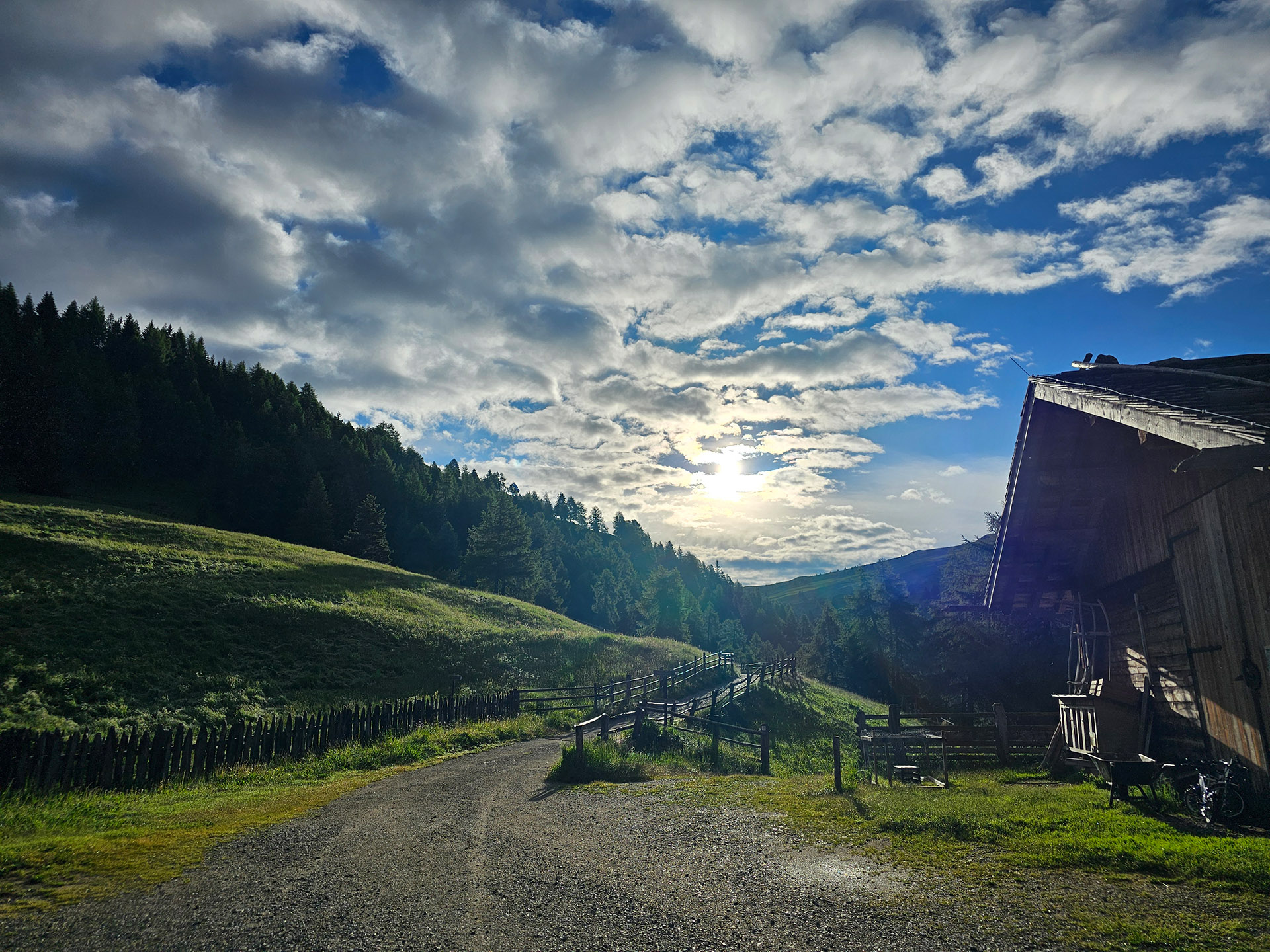
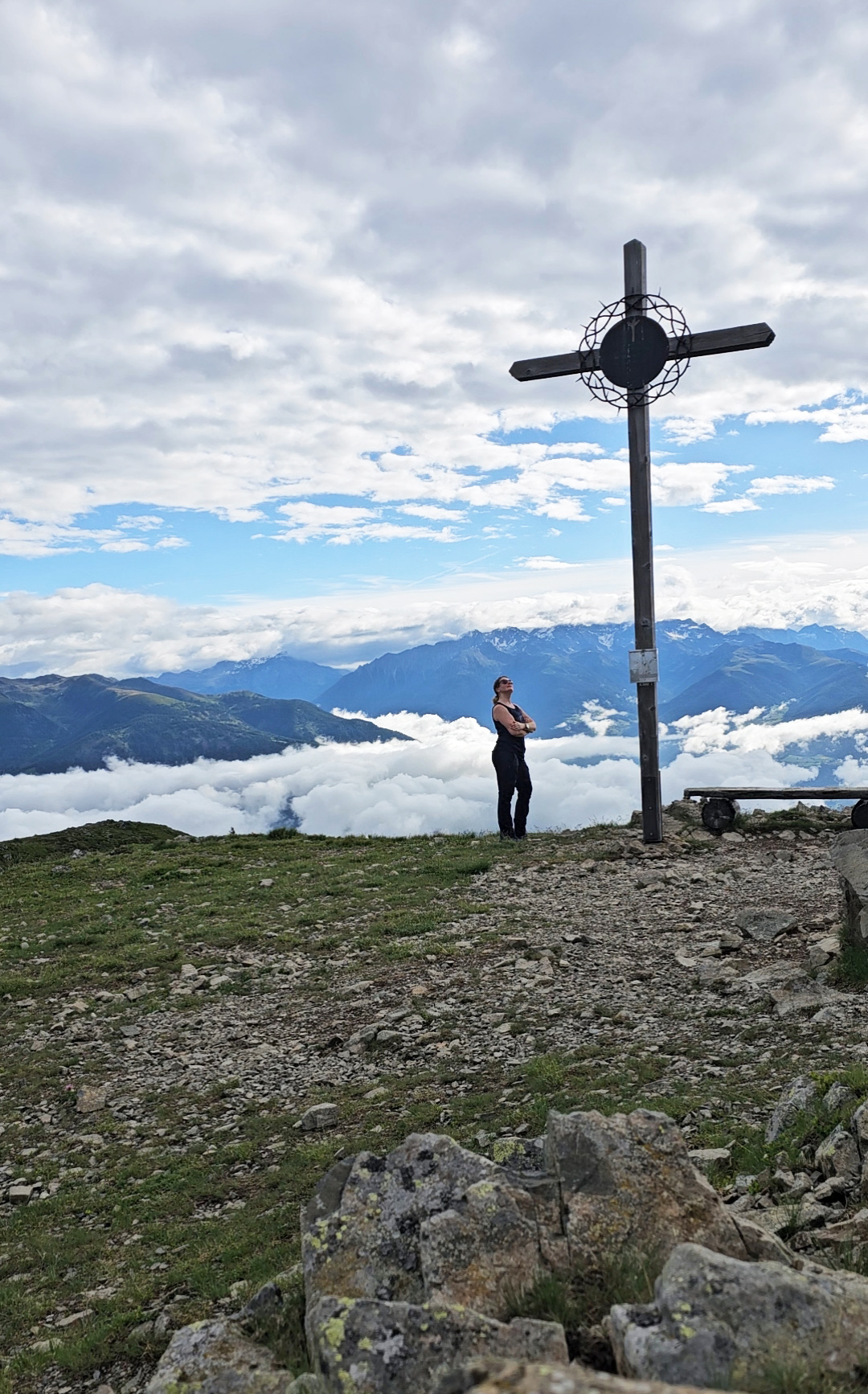
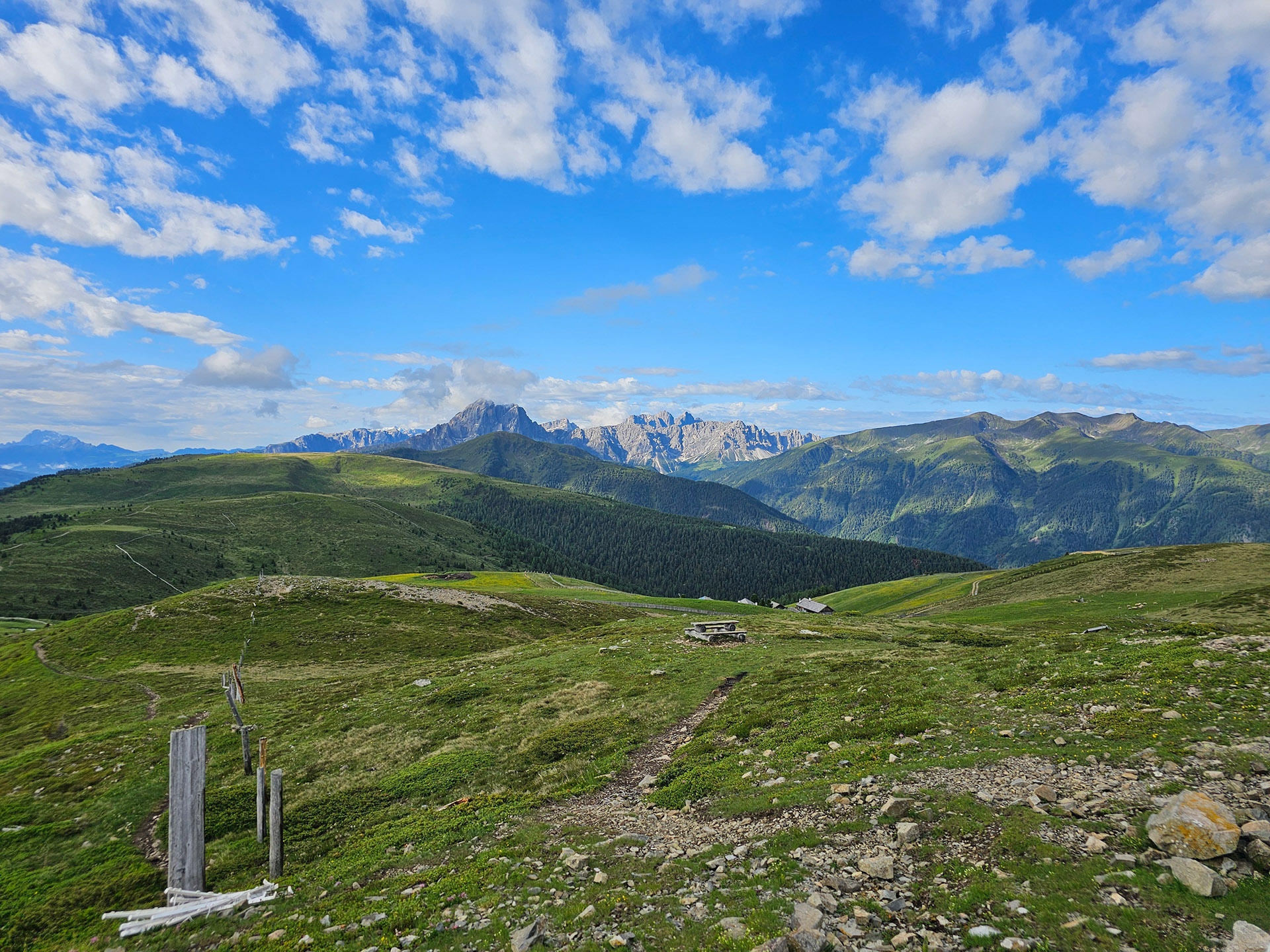
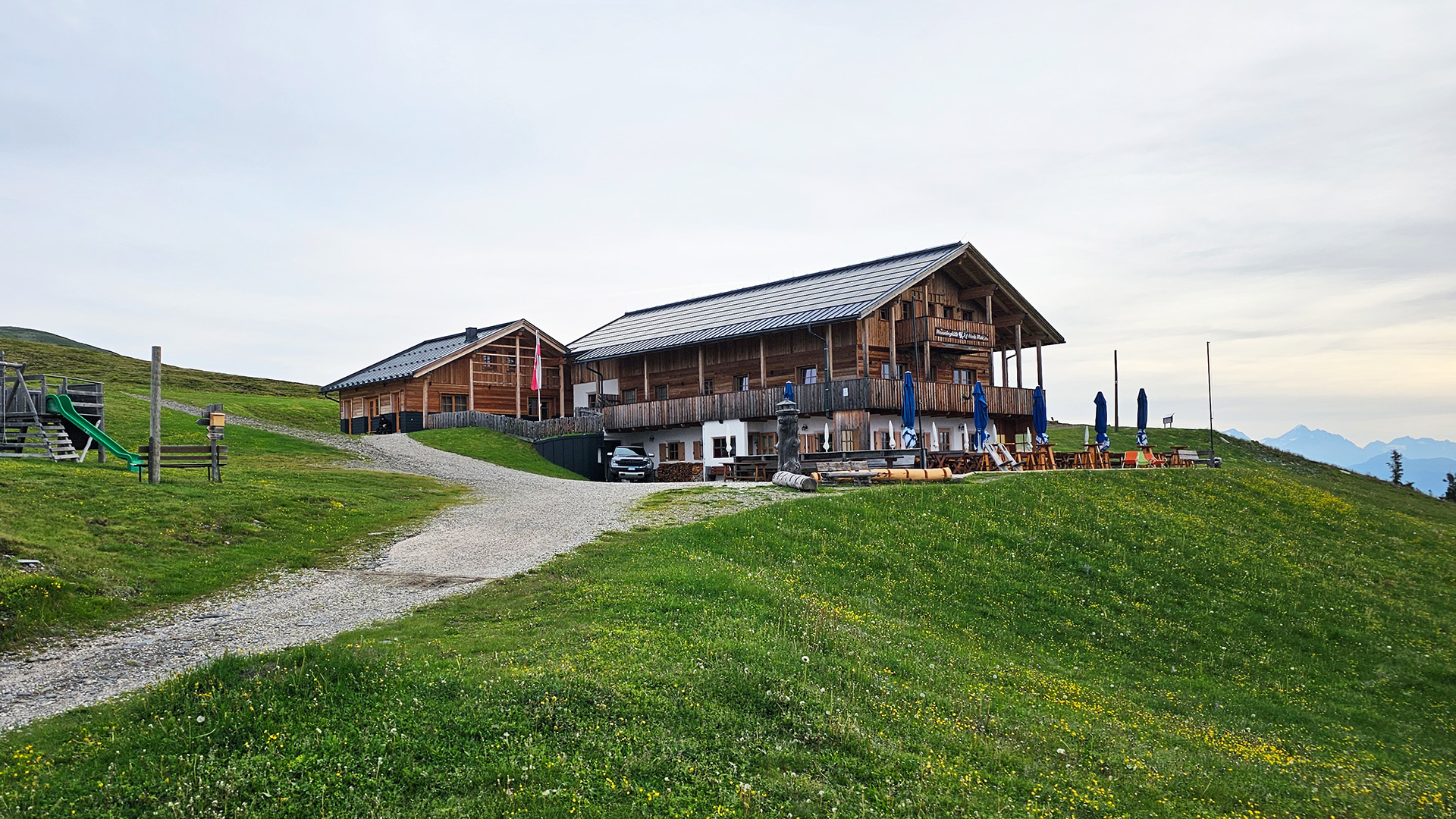
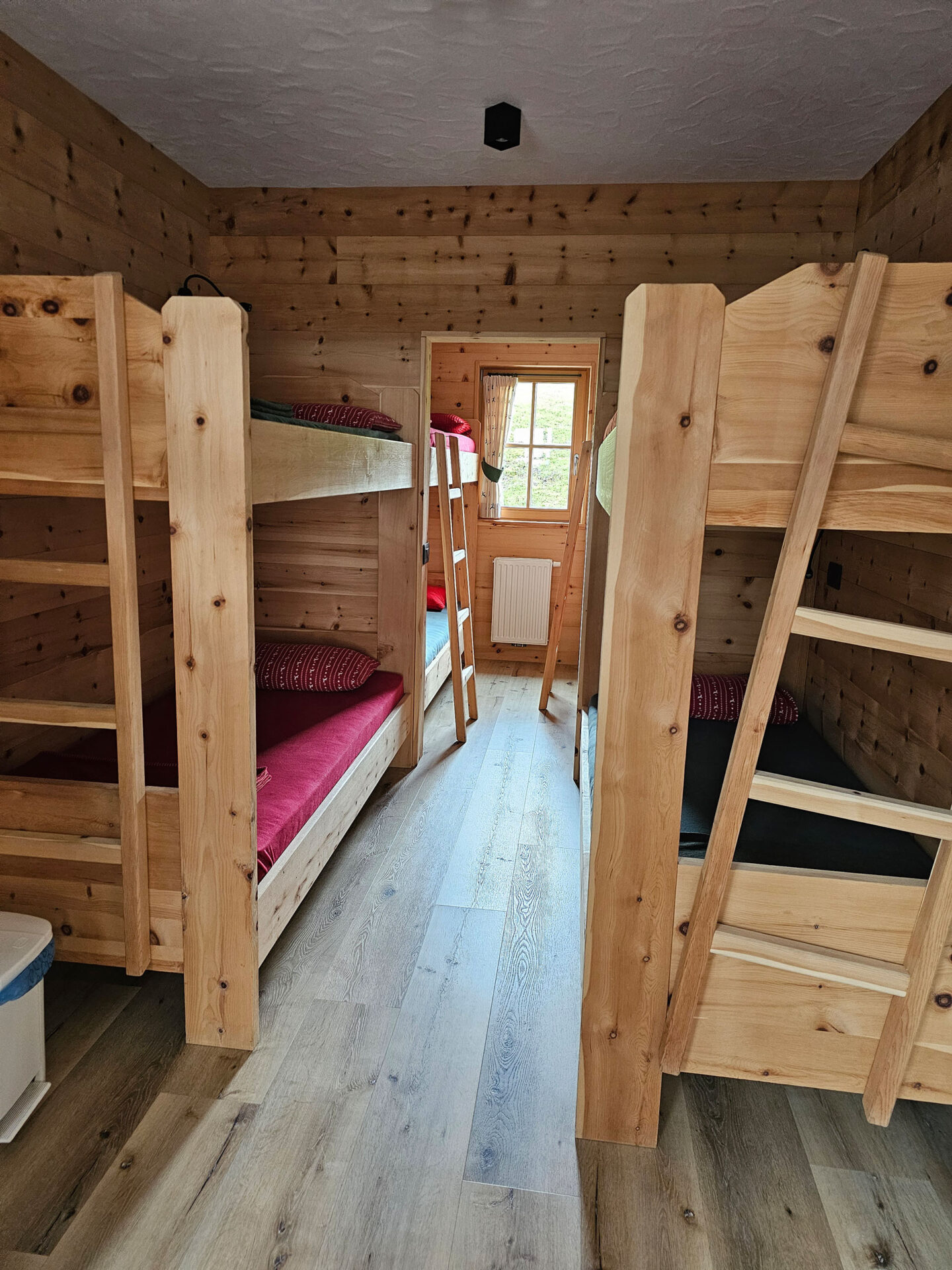
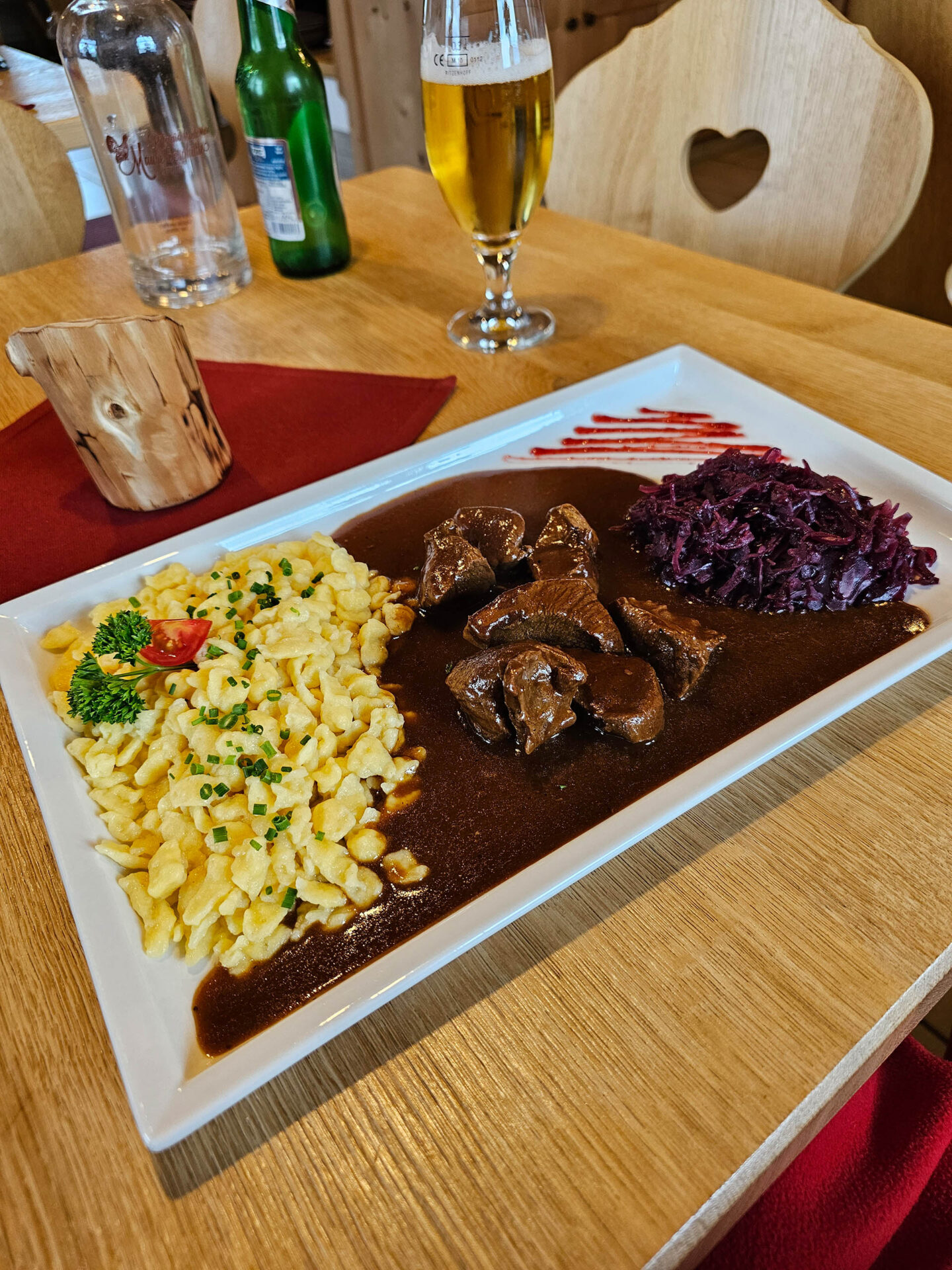
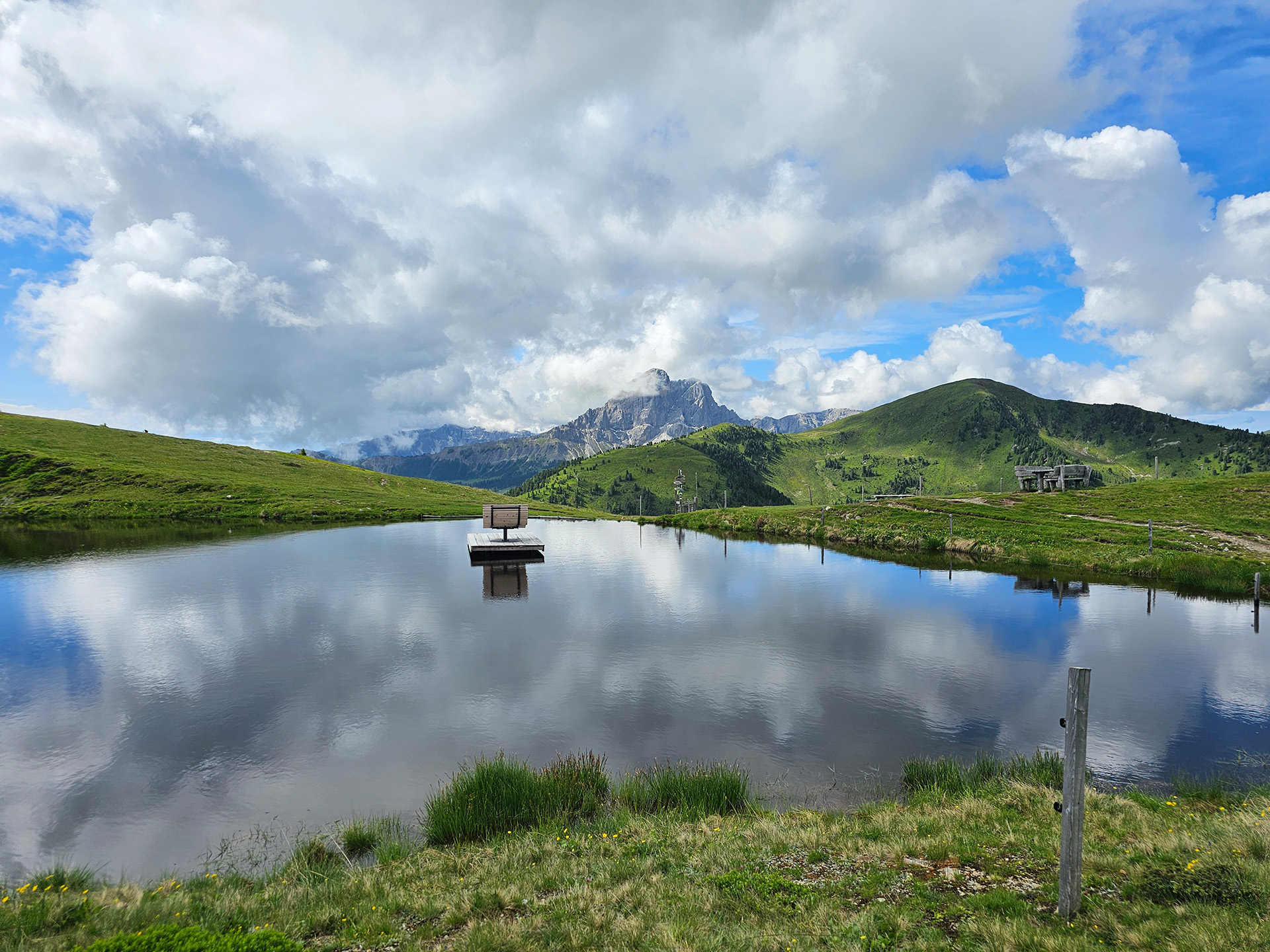
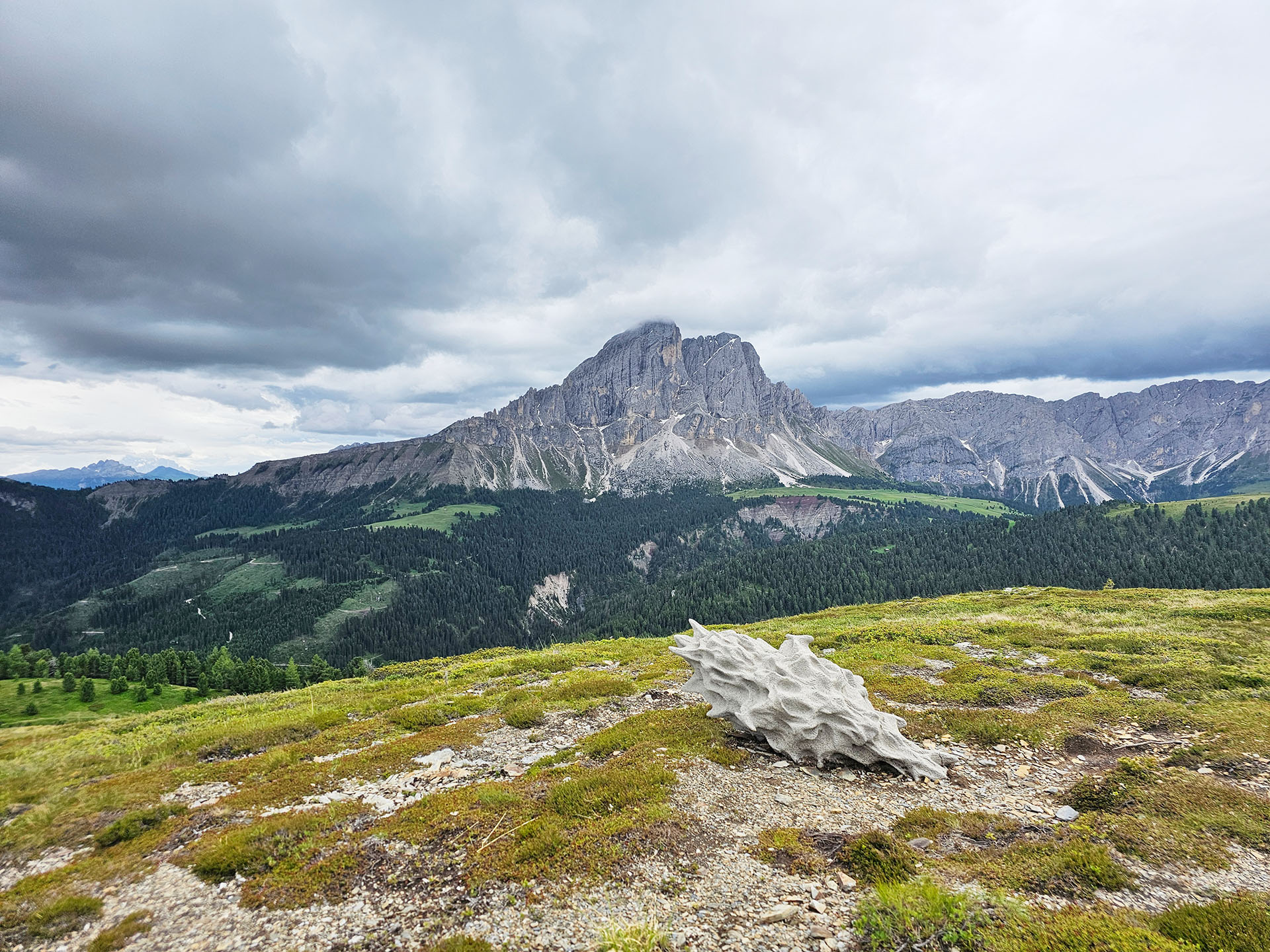
Stage 3: from the Maurerberghütte to the Schlüterhütte
Distance: 15.3 kilometres | Duration: 4:45 hours | Elevation gain: 810 metres | Elevation loss: 640 metres
Check out my tour on Komoot
The day dawns clear and sunny, and as I set off after breakfast, I enjoy the fantastic view of the Peitlerkofel once again. The first section of the trail is all downhill, and I am aware of how many metres of elevation I still have to climb today, so I know that everything I am descending now, I will have to climb again later.
Right at the start of the trail, I meet a Dutchman, and we strike up a conversation because we are going the same way. He is also on the Dolorama trail; it is his first real mountain tour, and he actually wanted to go with a friend, but his friend had to cancel at the last minute. Feiko and I decide to walk together for now, but we leave it open to split up again later. That doesn't happen – we get along great from the very first few metres and chat non-stop.
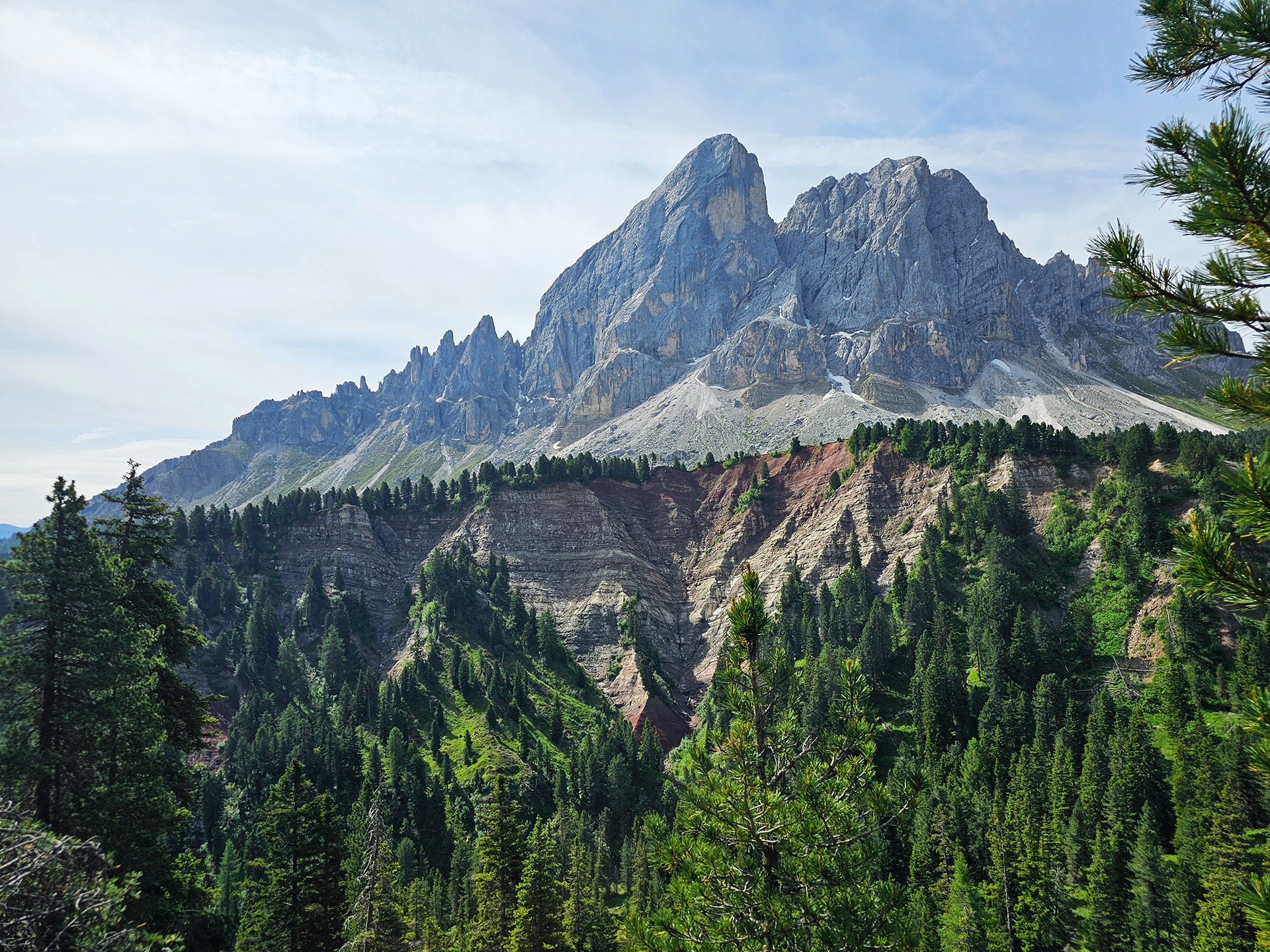
Once we arrive at Würzjoch, at the foot of Peitlerkofel, an impressive sight awaits us: a huge landslide shows us the elemental force that lies in the mountains.
We are less enthusiastic about the sudden crowd of people around us. There is a very large car park here, and many day trippers arrive by bus and car.
Feiko and I meet a Dutch couple who are on the same route as us, and we stop for refreshments at the Ütia de Börz mountain hotel, where we enjoy a slice of cake and a coffee. We all get on very well, and as we continue on our way, we know that even though Feiko and I are faster, we will see each other again at one of the next huts.
You can walk around the Peitlerkofel on the western and eastern routes; we are taking the eastern route. Even though I don't know the other route, I can highly recommend this one. It is very relaxing to walk, and you quickly feel like the Nine Companions from Lord of the Rings when they set off together from Rivendell.
But the altitude gains are coming, and it's a really steep climb up to the Göma Joch. There we stand in front of the south face of the Peitlerkofel and enjoy an incredibly beautiful view of the vast alpine landscape stretching out below us and the impressive peaks of the Puez-Geisler National Park opening up behind it. As is so often the case in the Dolomites, it is so beautiful that you cannot believe your eyes, even though you had the same view just 10 seconds ago.
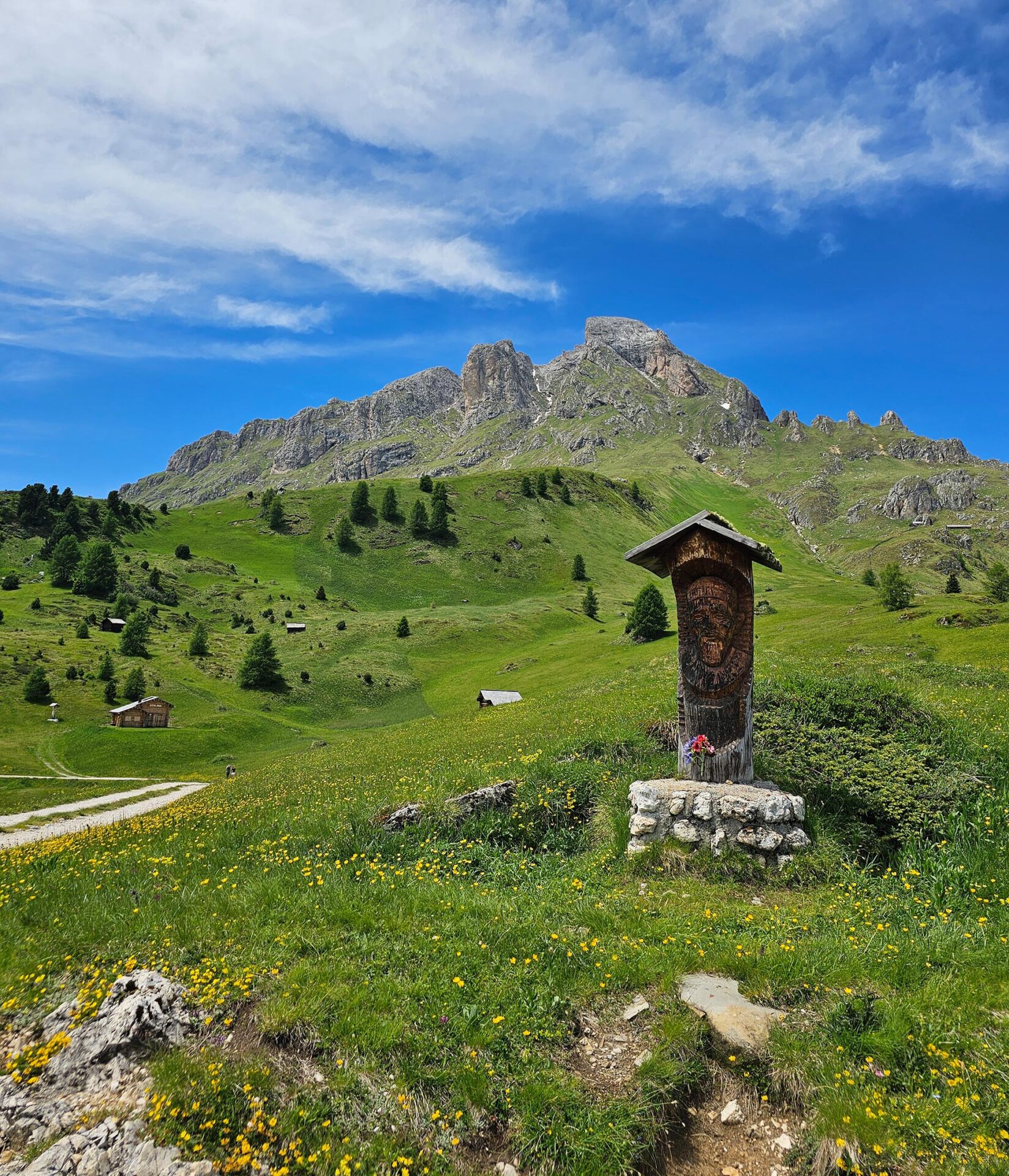
From the Göma Joch, we take a leisurely stroll along an almost flat alpine path to the rustic Utia Vaciara, where we treat ourselves to a break with snacks and enjoy the fantastic view.
The last part of this stage, from Utia Vaciara to the Schlüterhütte, is quite challenging. It is a very steep climb, and Feiko and I decide to add an extra loop and climb a grassy hill next to the path to enjoy the unique panoramic view.
I really love the Schlüterhütte and it's my favourite hut on this tour. The owners are really nice, instead of a large dormitory there are 6-bed rooms and the toilets have the best view ever! The hut is in an incredibly beautiful location and the sunsets are simply amazing.
Feiko, myself and the friendly Dutch couple conclude the day with an Aperol Spritz. We bid farewell: all three of them must continue on to the next hut, but from here it is only downhill. What a fantastic day with delightful hiking companions!
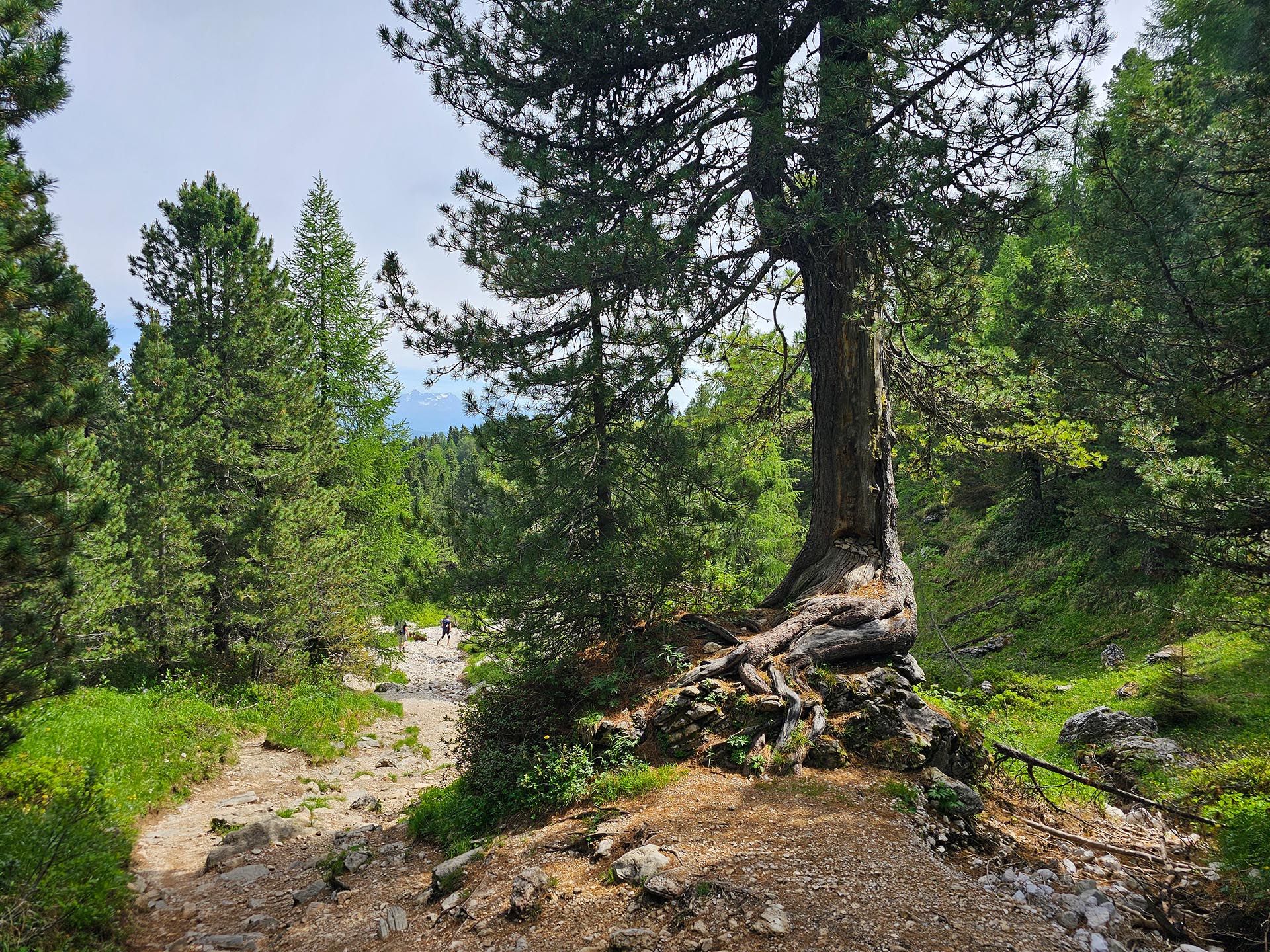

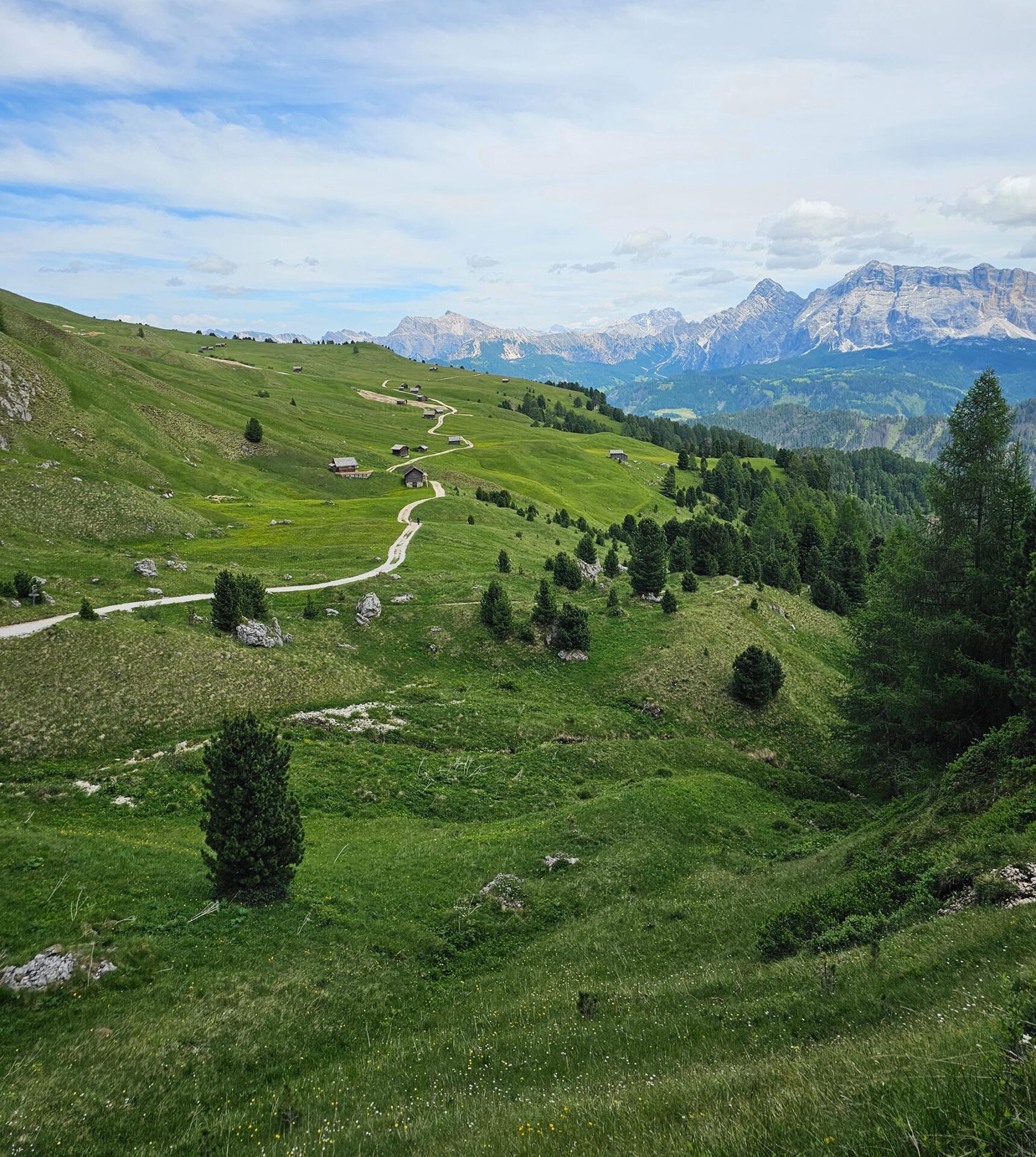
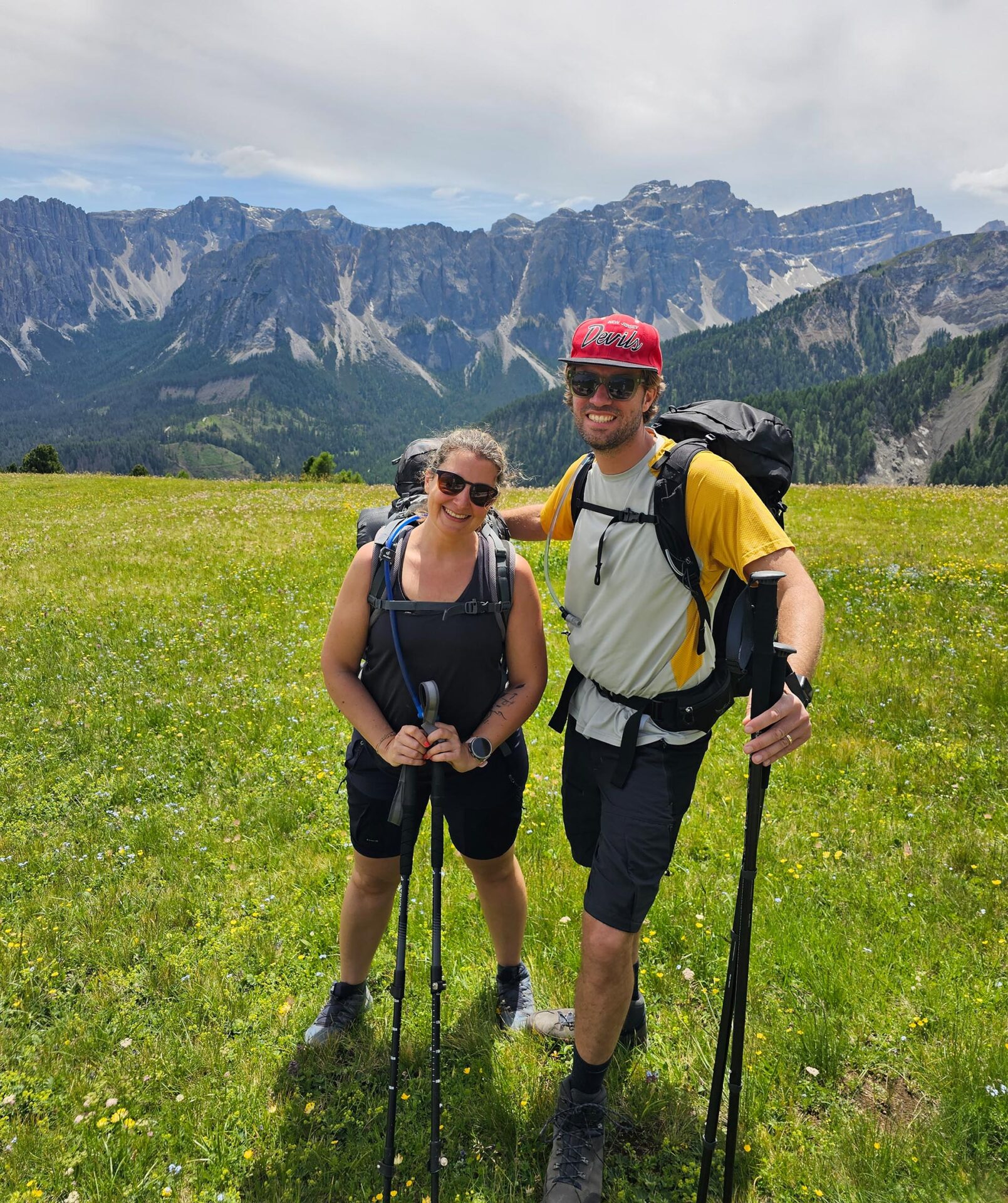
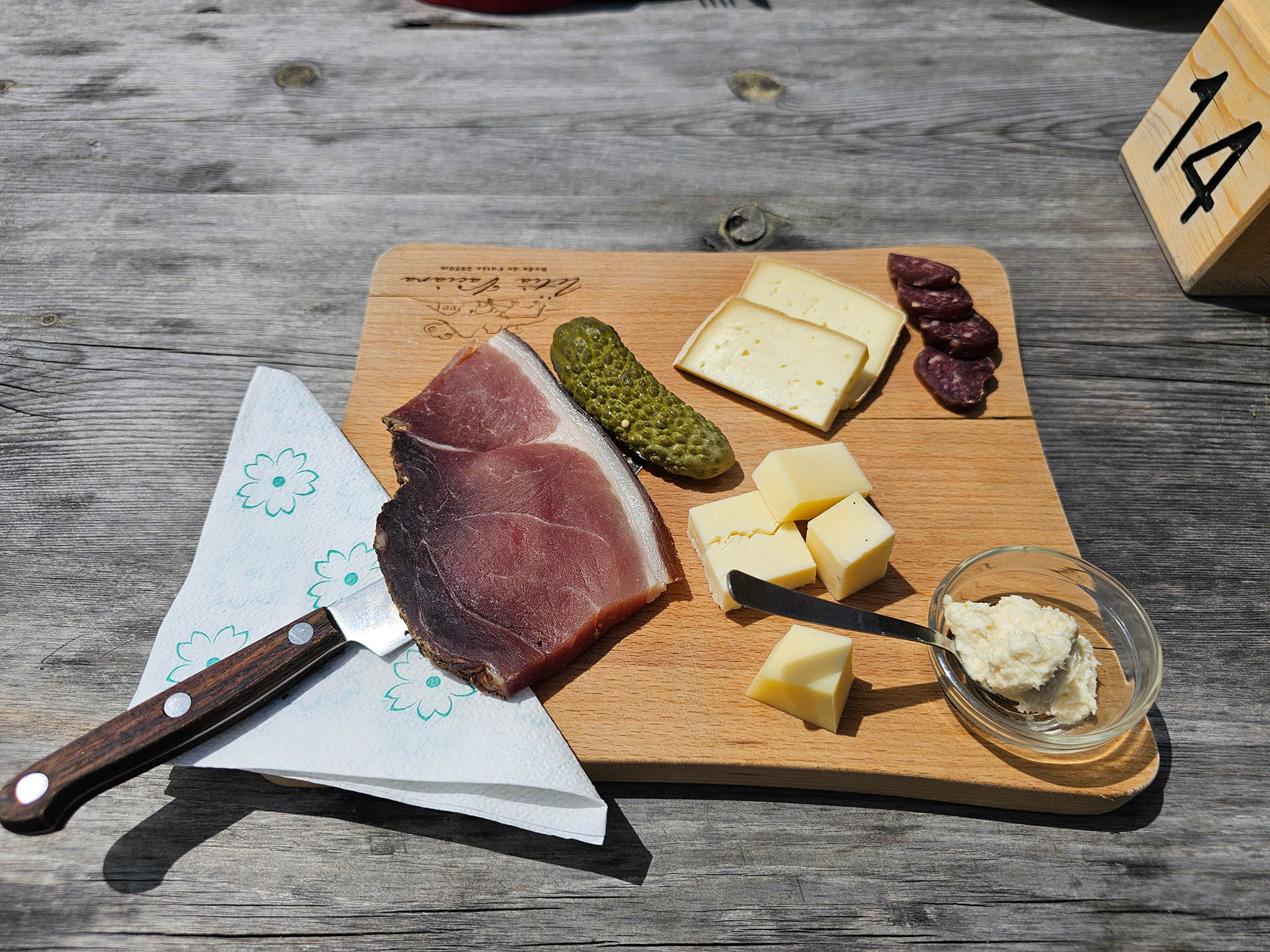
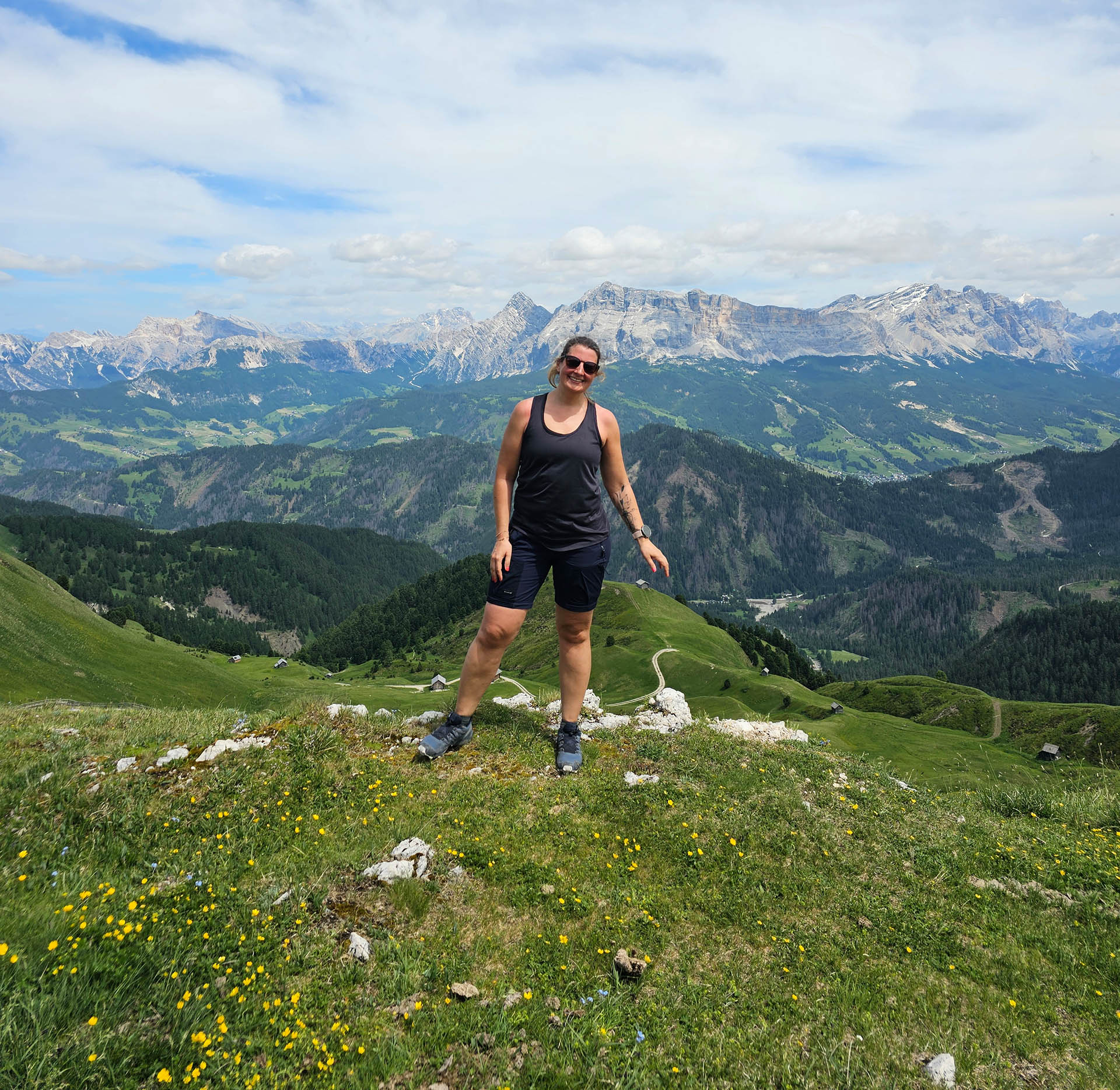
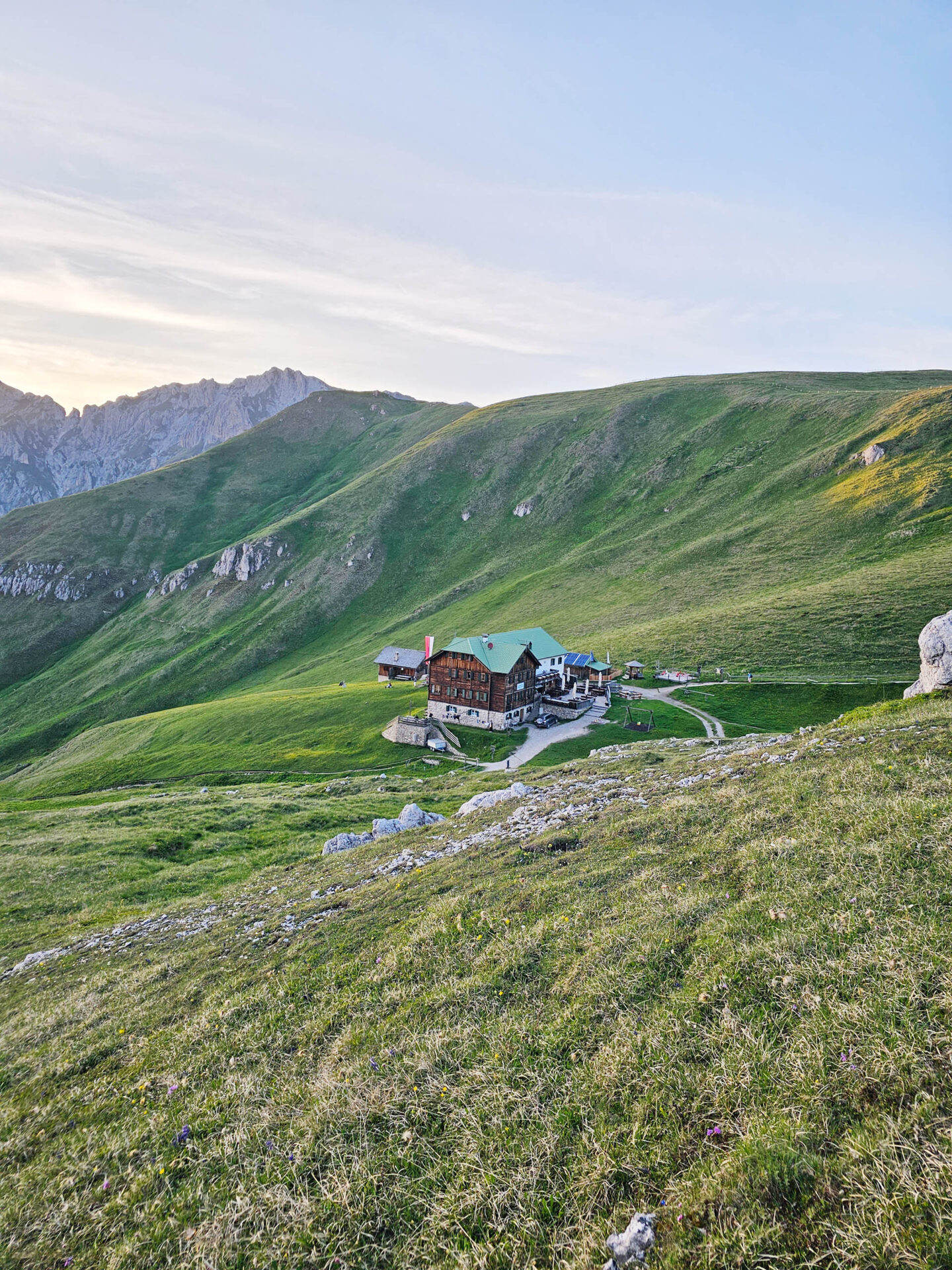
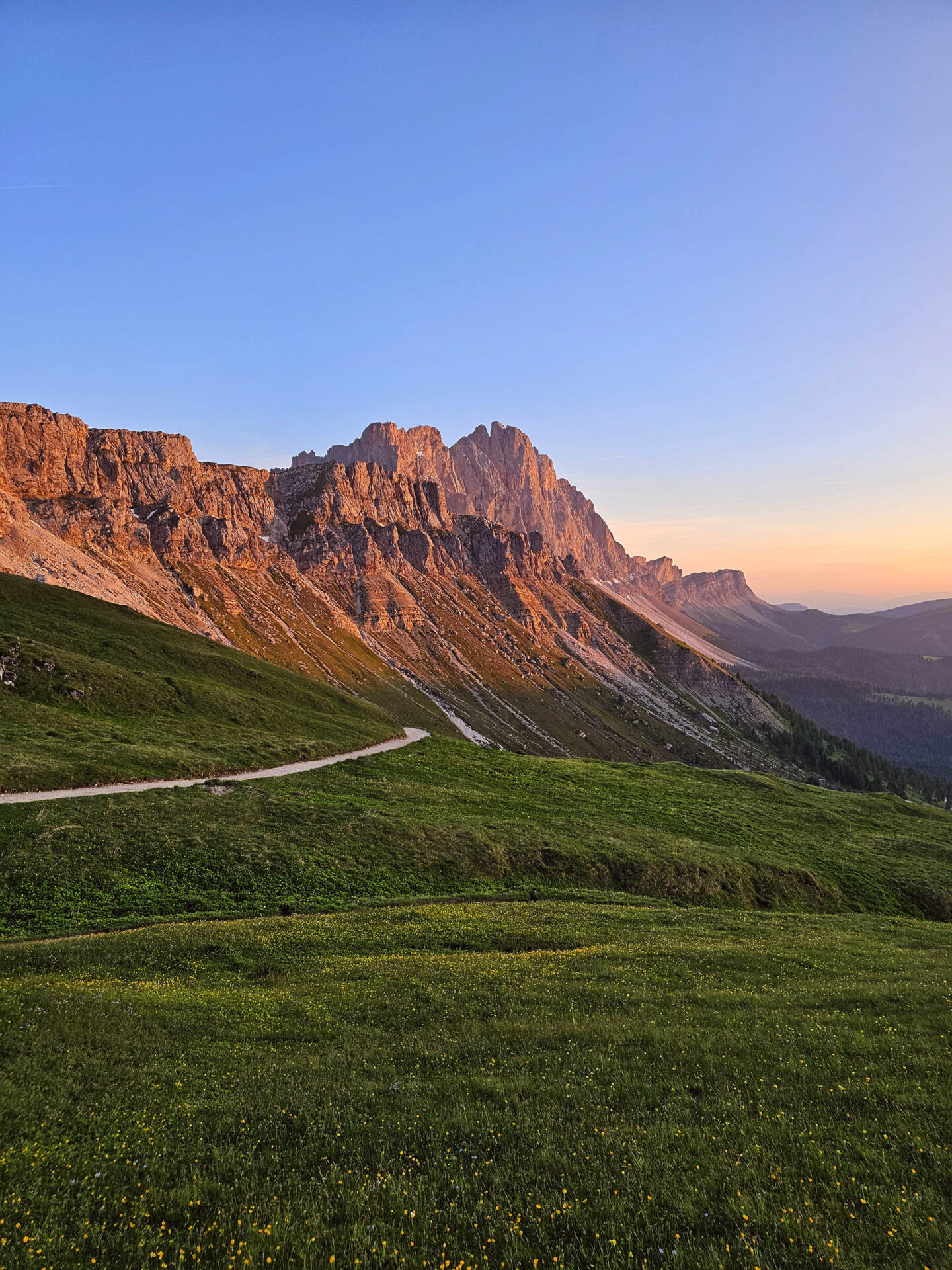
Stage 4, which for me is not a stage but a day hike
Distanz: 7,46 Kilometer | Dauer: 3:00 h | Höhenmeter bergauf: 580 m | Höhenmeter bergab: 580 m
Check out my tour on Komoot
The actual stage of the day would lead from here to the Raschötzhütte. However, I couldn't get a place to sleep there, so for me the actual Dolorama Trail ends at the Schlüterhütte, where I have booked two nights. What annoyed me at first turns out to be a stroke of luck. I'm going on a day trip and have set my sights on the Peitlerkofel. Having already circumnavigated it, I'm going to climb it today so that I really know it from all sides.
As always, I start very early. I was already at breakfast with my backpack packed and ready to go, and I can set off straight afterwards. It is around 7:30 a.m., and I am alone on the open road as I cover the 25 minutes or so to the start of the Peitler. Incidentally, setting off early is also advisable on warm days because the ascent offers no shade and the rocks heat up quickly.
The hike up to Peitlerkofel is not difficult, but it is steep and uphill without interruption. It becomes very rocky and scree-covered, but there are no exposed sections.
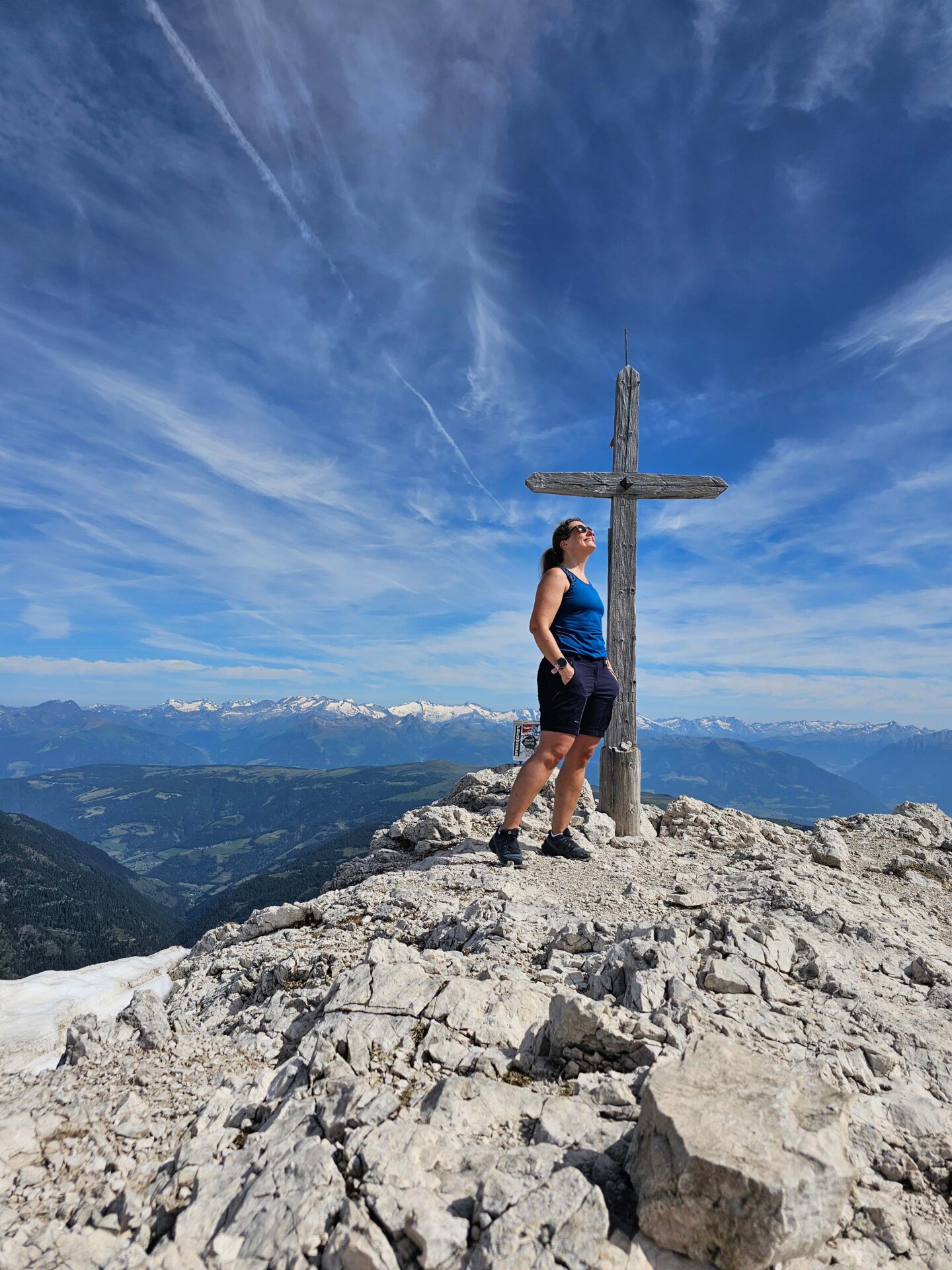
It has two peaks – I aim for the lower one, because the actual summit can only be reached via a via ferrata, it is completely exposed, and I get panic attacks just looking at it. I don't meet anyone on the way up, and I also have the summit cross of the Kleiner Peitlerkofel all to myself during the half hour I spend there.
The weather is at its best, I have a 360° view, I am standing at 2,813 m and feel as if I am on the highest mountain on earth. It is wonderful – the Dolomites are once again burning deep into my heart! ❤
As I descend, I encounter the hikers one after the other. Three cheers for early risers! They have to share the summit, while I had the mountain all to myself.
Around noon, I am back at the Schlüterhütte. I enjoy the afternoon with homemade cake, coffee and my e-book reader on the beautiful terrace. After dinner, I climb the hill next to the hut, sit down in the alpine meadow and enjoy the beautiful sunset spreading over the valley.
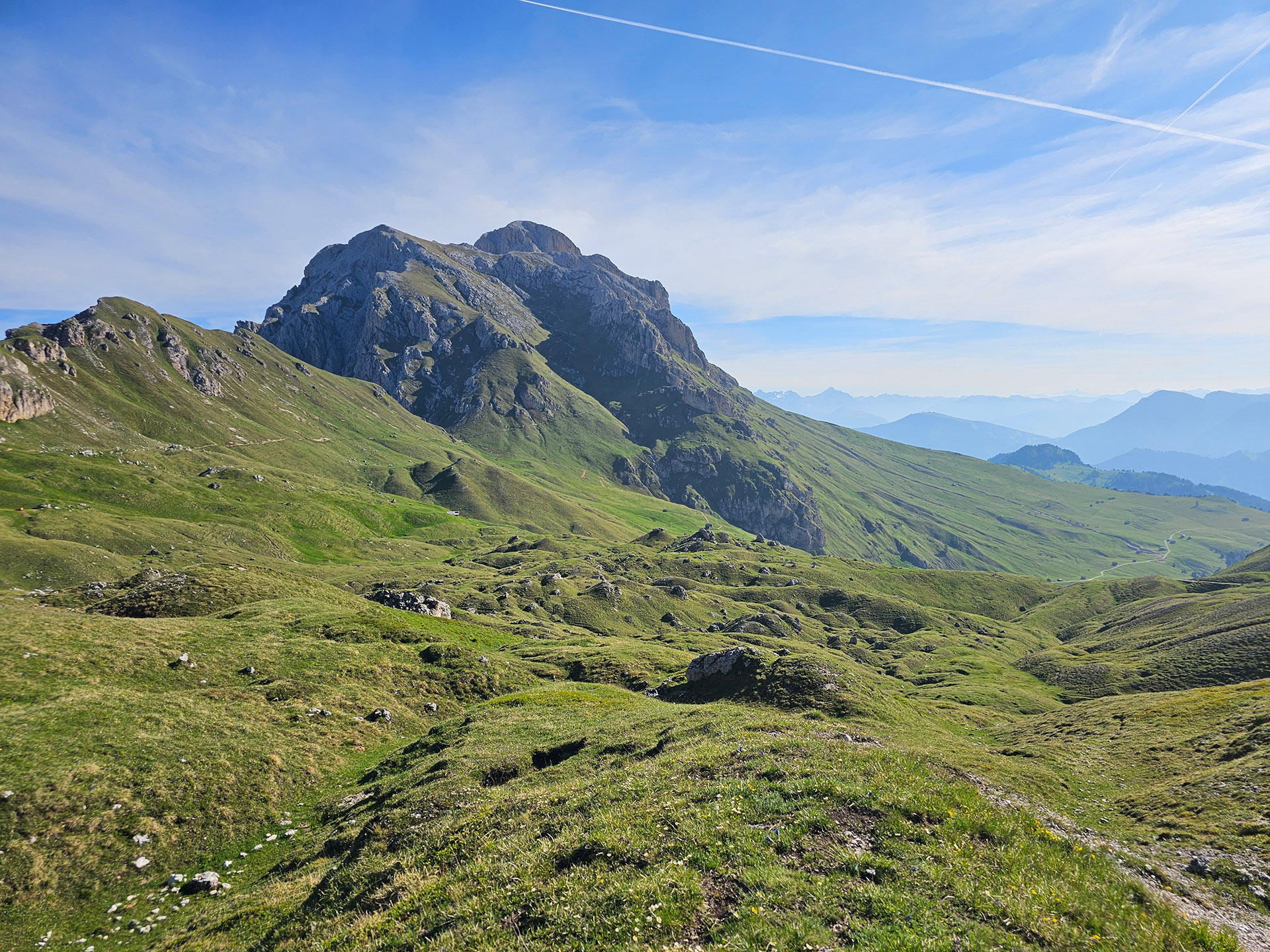
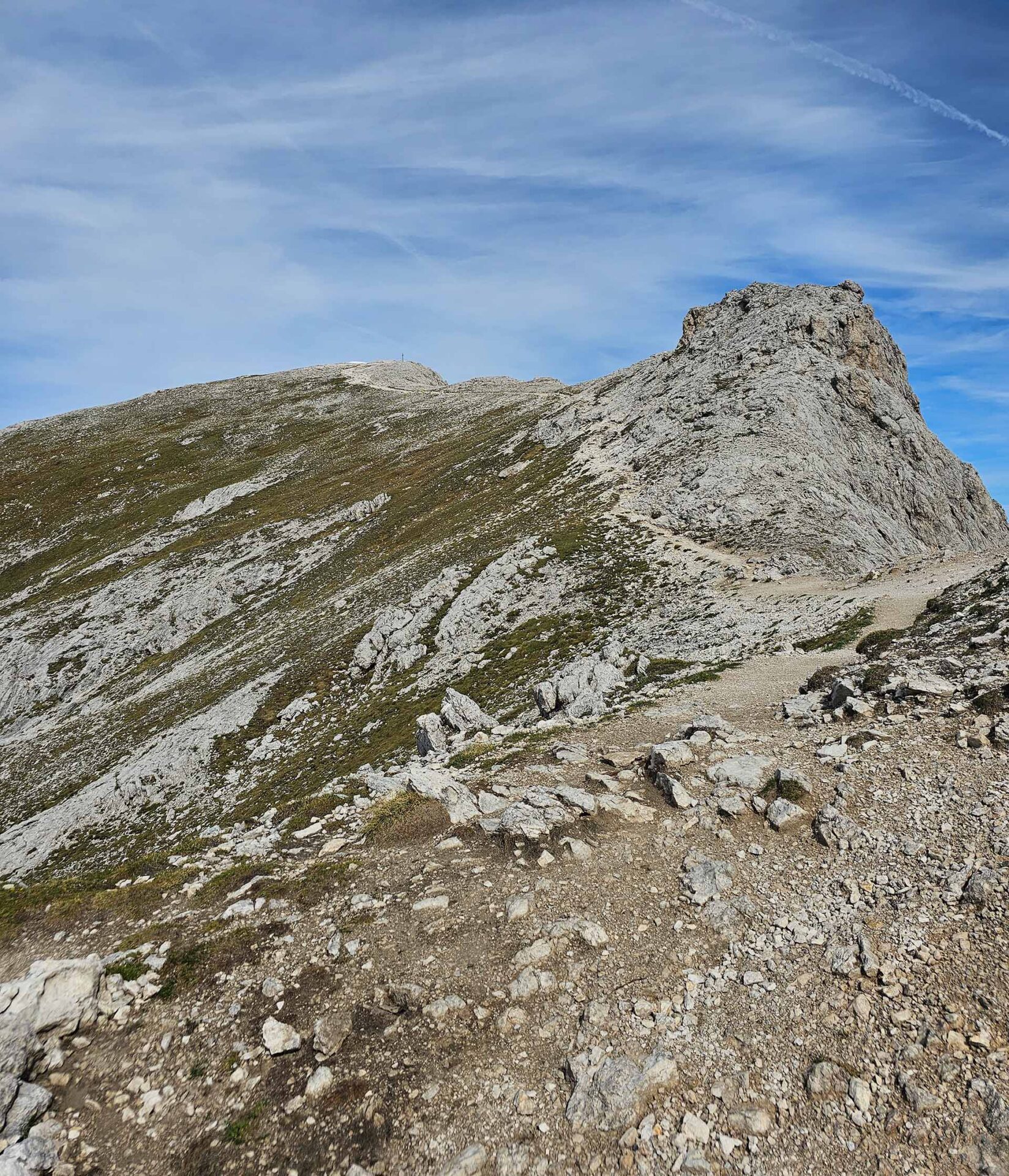
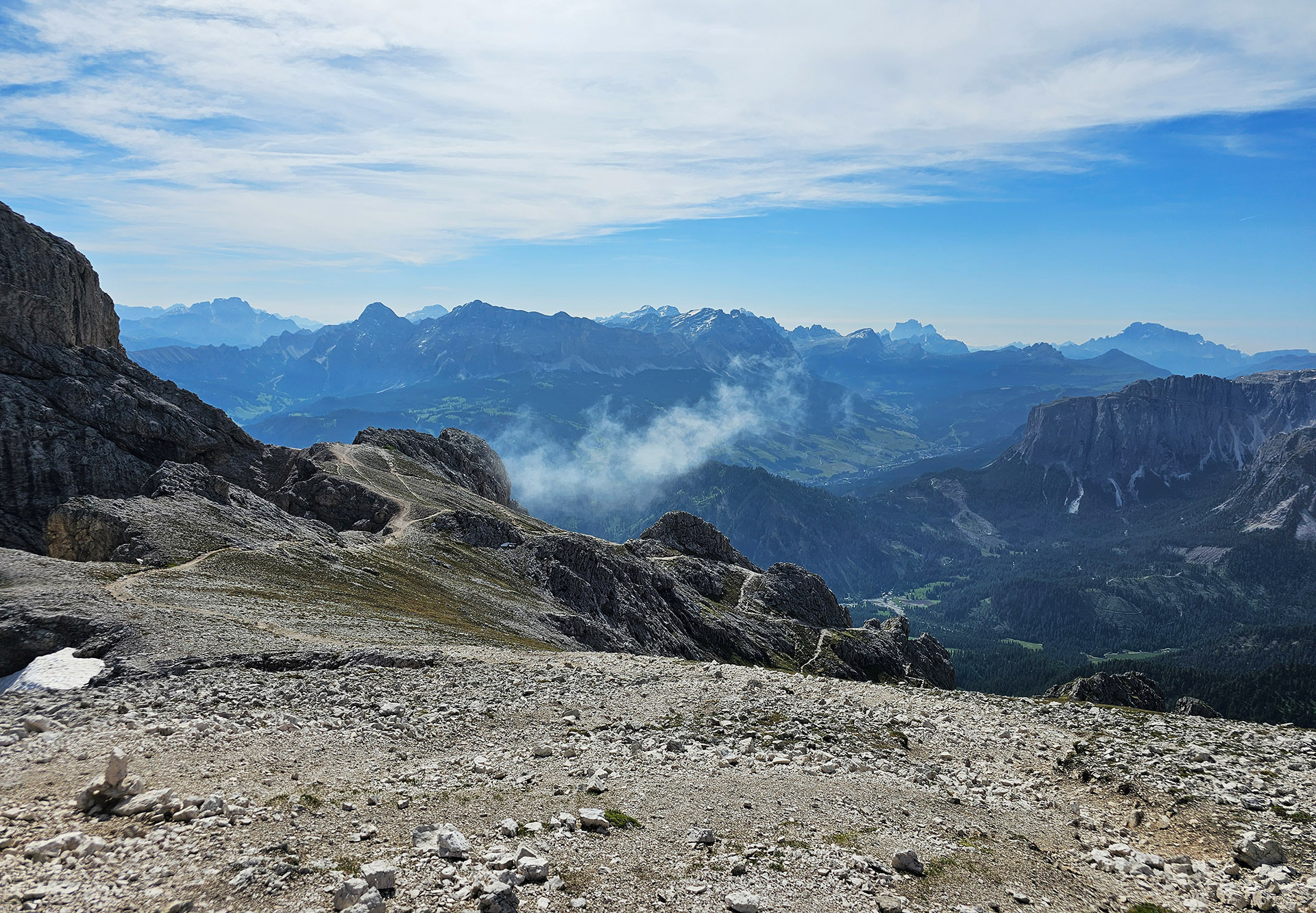
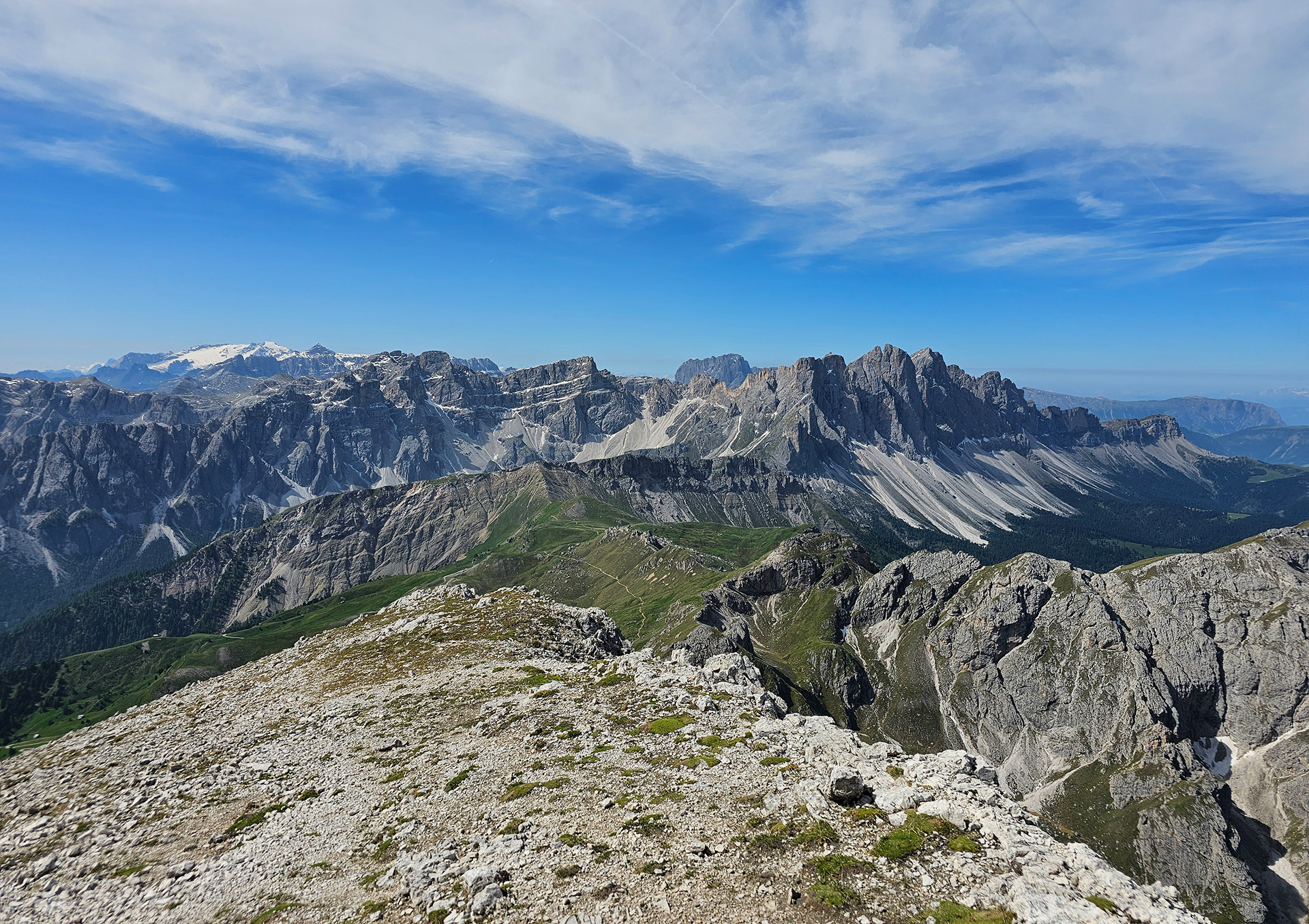
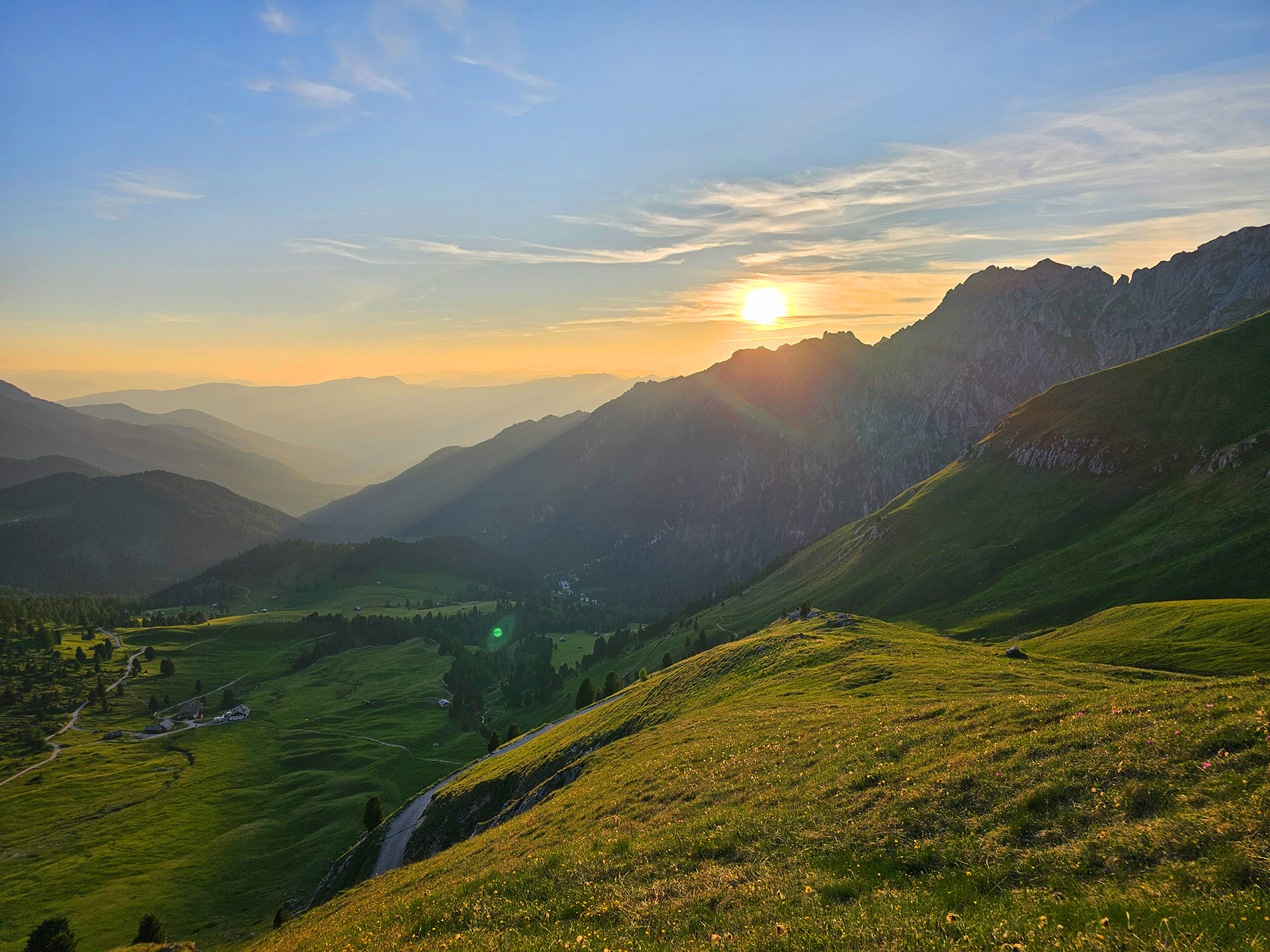
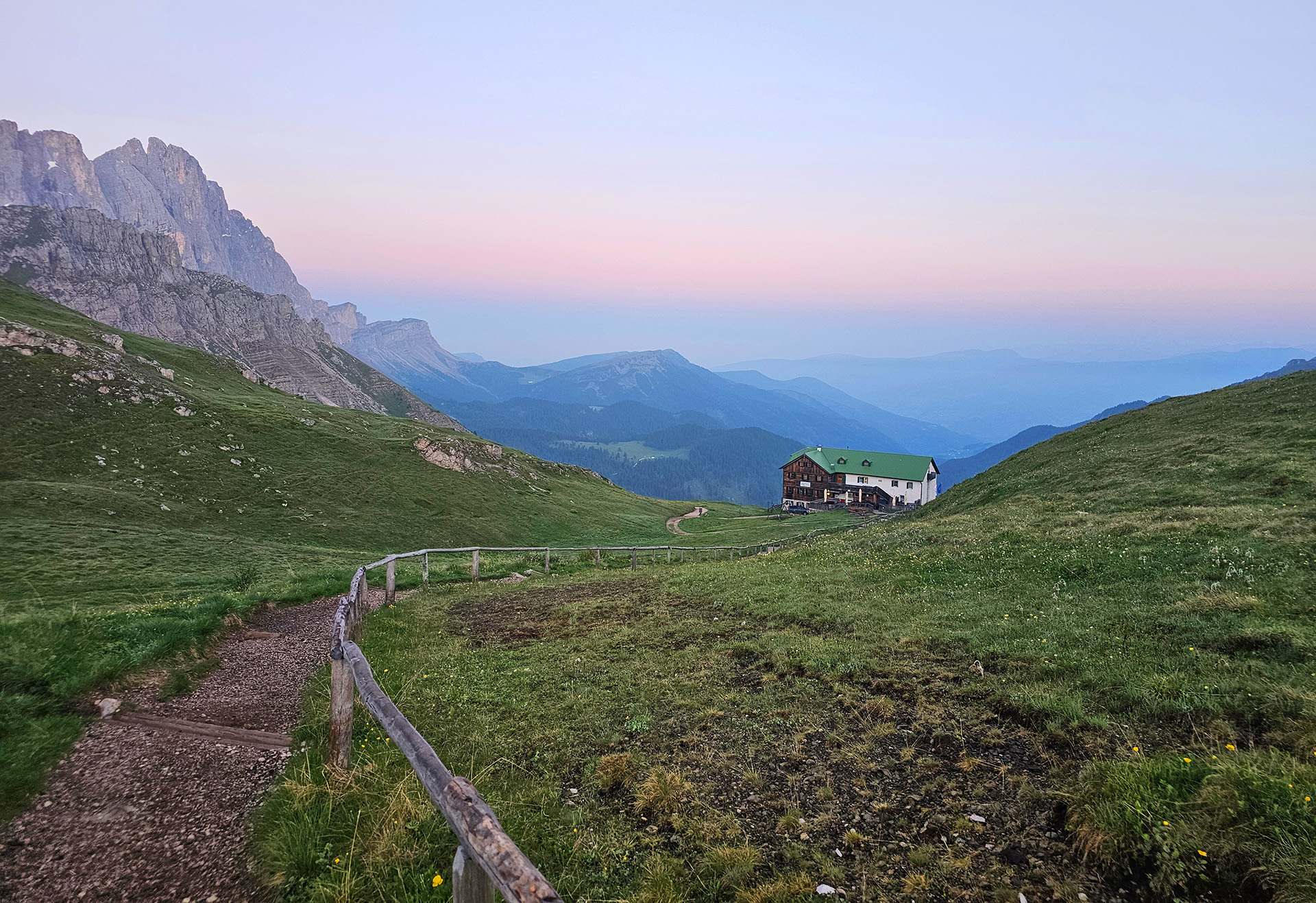
Stage 5 – the descent
Distanz: 3,87 Kilometer | Dauer: 1:10 h | Höhenmeter bergauf: 0 m | Höhenmeter bergab: 600 m
Check out my tour on Komoot

The last day has arrived, and I can hardly believe it.
But first, the early riser gets up extra early – I want to experience a sunrise at least once. No sooner said than done. Unfortunately, it's not really spectacular, but the morning freshness and absolute tranquillity are still wonderful.
After breakfast, during which I have a very pleasant chat with an American family, I set off. From here, it's all downhill. Since I'm missing a stage, I don't end up in Lajen, but at the Zanser Alm car park. That's the great thing about the Dolomites – there's always a valley you can descend into, and the public transport is excellent.
On the last few metres, I can't get enough of the Furchetta peaks. Partly because I know that this will be my last glimpse of the impressive Dolomite massifs. All that remains for me is the journey home, and I know that in just a few hours I will be back in flat central Upper Austria. If I had enough time, I would return to the starting point from here without hesitation and immediately walk the same route again.
So I get on the hiking bus that takes me to the train station in Brixen, from where I take the train home via Innsbruck.
It is quite evident that this was one of the most memorable holidays of my life. I will definitely return to Dolorama next year at the latest. Even as I write these lines, I am glancing at my calendar to see if I can squeeze in a quick hiking weekend in the Dolomites in September. Anyone who comes here and does not leave a piece of their heart behind forever cannot truly possess one.
My equipment for long-distance hiking
I have a 30 + 10 litre backpack, which was a bit small, but it worked out fine. And that was all with:
- Hydration system (I find this SO much more useful than a water bottle because it helps you stay better hydrated)
- Hiking poles
- Zip-off hiking trousers
- Softshell jacket
- Sunglasses
- Baseball cap
- Slippers for the cabins
- Two panniers for my clothes, so that everything is neatly organised:
- A bag with underwear (underpants, sports socks, three sports bras)
- Another bag with shirts, one for each day, including a long-sleeved shirt in case it gets cold, as well as a fleece jumper, leggings and two pairs of normal socks for the hut.
- Ein mittelgroßes Microfaser-Handtuch und ein Waschlappen
- Badezimmer-Utensilien: eine Seife, die sich für Gesicht und Körper eignet, Zahnbürste und Miniatur-Zahnpasta, Miniatur-Shampoo und -Conditioner, Hautcreme, Blasenpflaster, Mini-Bürste und Kamm
- Sun protection for face and body (high sun protection factor!)
- Sleeping bag (I didn't have a hut sleeping bag, but a proper sleeping bag, because I wasn't sure whether I would be too cold with a hut sleeping bag and wool blanket)
- Long rain poncho that also fits over a backpack
- Sufficient cash, bank card (you can pay by card almost everywhere, but it is advisable to have enough cash with you), alpine club card, identity card, smartphone, e-book reader, sports watch, all necessary charging cables
- Energy snacks (e.g. muesli bars)
- Kleine Müllsäcke, ein Schmutzwäschesack
What I would additionally take with me next time:
- A pair of shorts for ‘leisure time’, as it was very warm in the sun in the afternoons and I only had a pair of long black leggings with me.
- Protein powder portion bags. I am now very conscious about what I eat and making sure I get my macros, and I generally don't eat meat anymore. But in order to get some protein in my meals, I had to order a meat dish almost every evening. I won't be doing that anymore and will use protein powder portions instead. But that's really just my own thing. 😅
What I would not take with me anymore:
- The unnecessary hut sleeping bag that I forgot to unpack after taking the large sleeping bag with me. 🙄
What you should theoretically have with you:
- A first aid kit and some wound ointment. I was confident that nothing would happen to me and that, since it is a well-travelled hiking trail, I would encounter someone who could assist me in an emergency. I was correct in my assumption, but it is still advisable to carry these items with you.
Recommended reading
I generally love the hiking guides in the Rother series; I consider them to be the best. In this case, I can highly recommend the Rother hiking guide ‘Hüttentouren Südtirol’ (Hut Tours in South Tyrol), which presents other easy multi-day tours in addition to the Dolorama.
And now it's your turn! ❤
Have you ever been on a multi-day hike? Where did you go, and how did you like it?




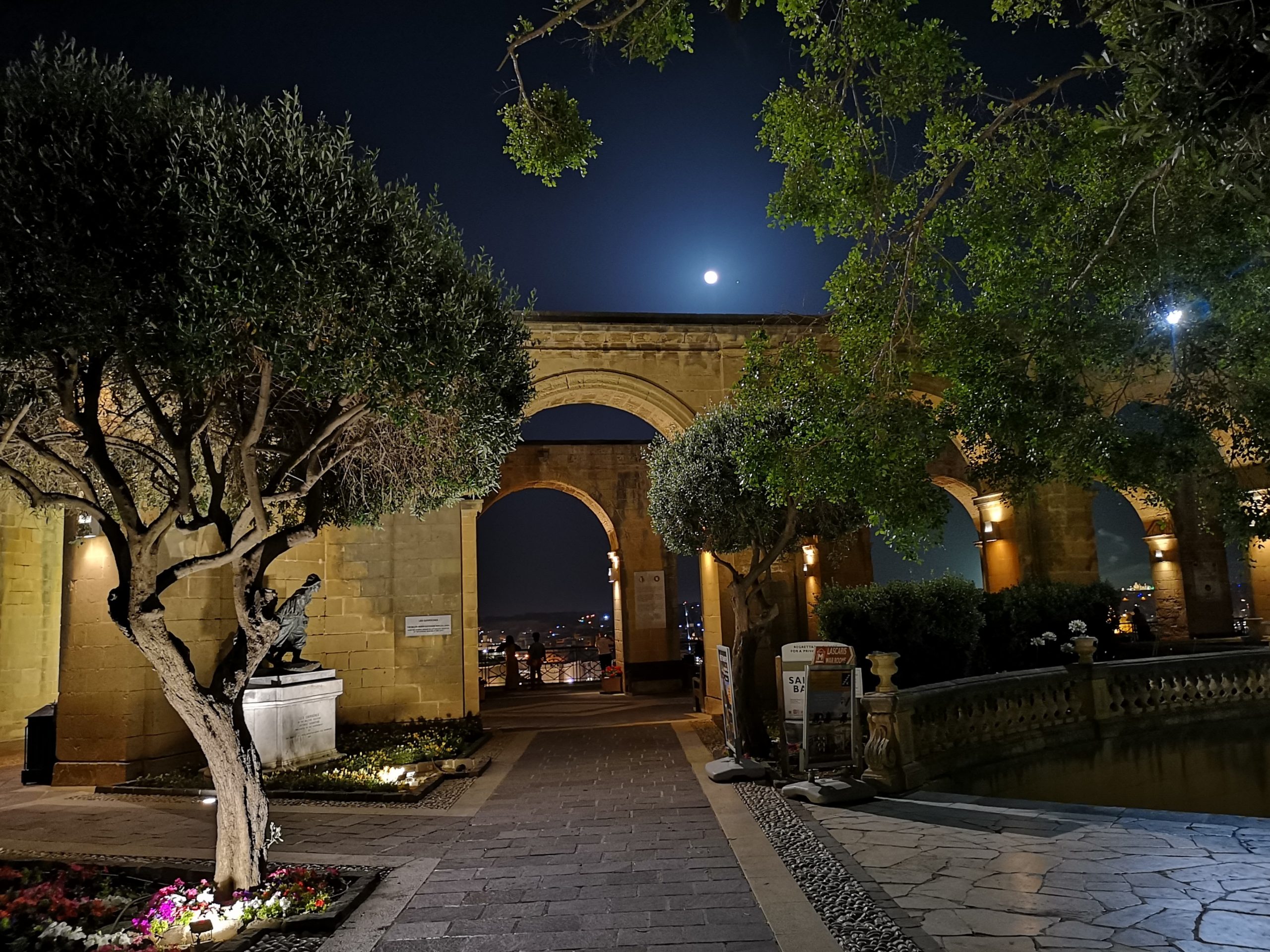
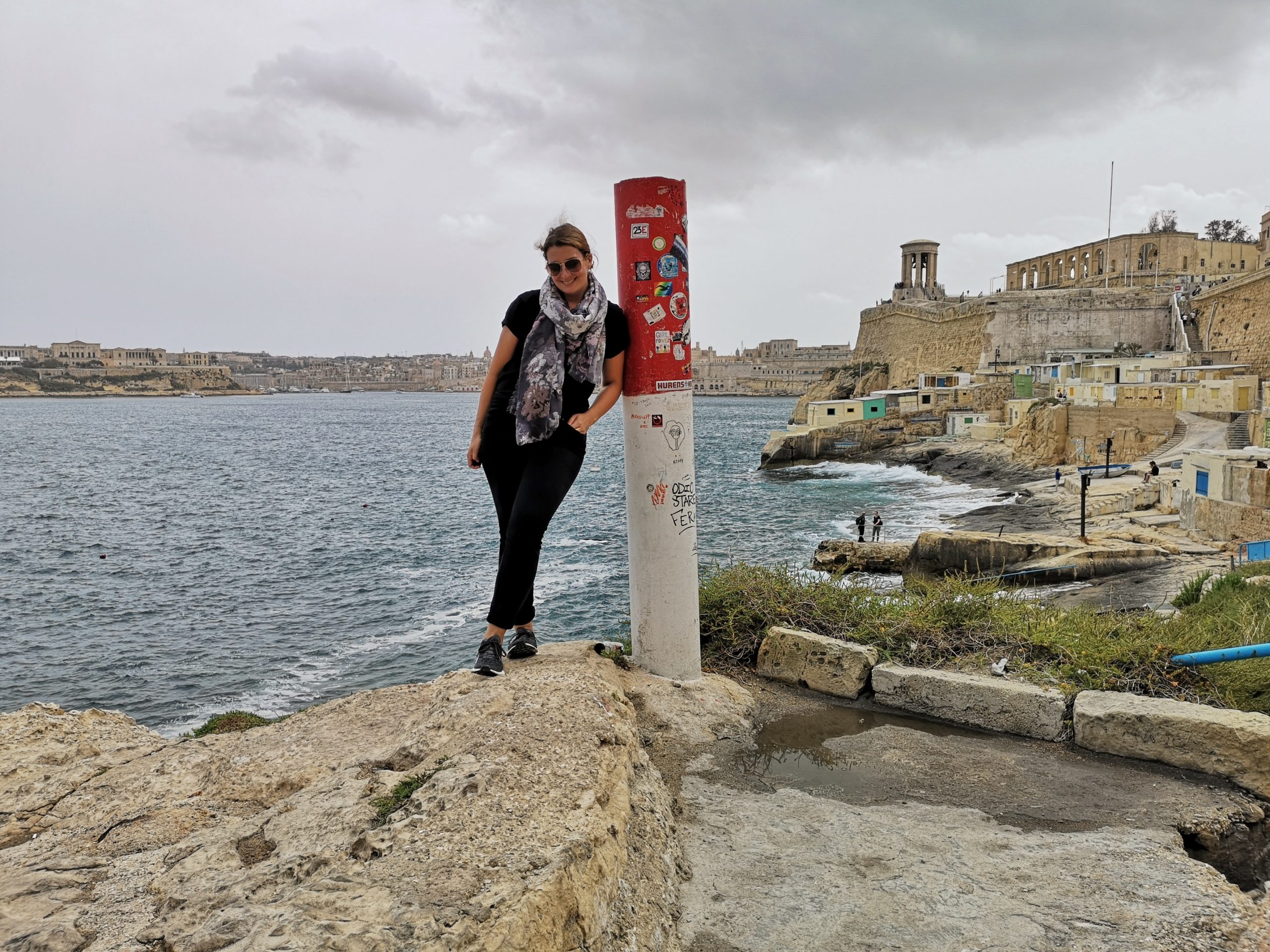
Dieses Bericht ist wirklich faszinierend und inspirierend! Die Beschreibung der Wanderungen, der wunderschönen Natur und der gemütlichen Hütten nimmt man gar nicht wahr, bis man selbst in den Dolomiten ist. Die authentischen Details über die Herausforderungen und kleinen Freuden machen die Reise lebendig. Ein Muss für alle Bergliebhaber!
Vielen Dank für deinen netten Kommentar! Die Dolomiten sind wirklich der Wahnsinn, oder? 🙂 Wenn man einmal dort war und die Berge liebt, dann kommt man nicht mehr los davon!